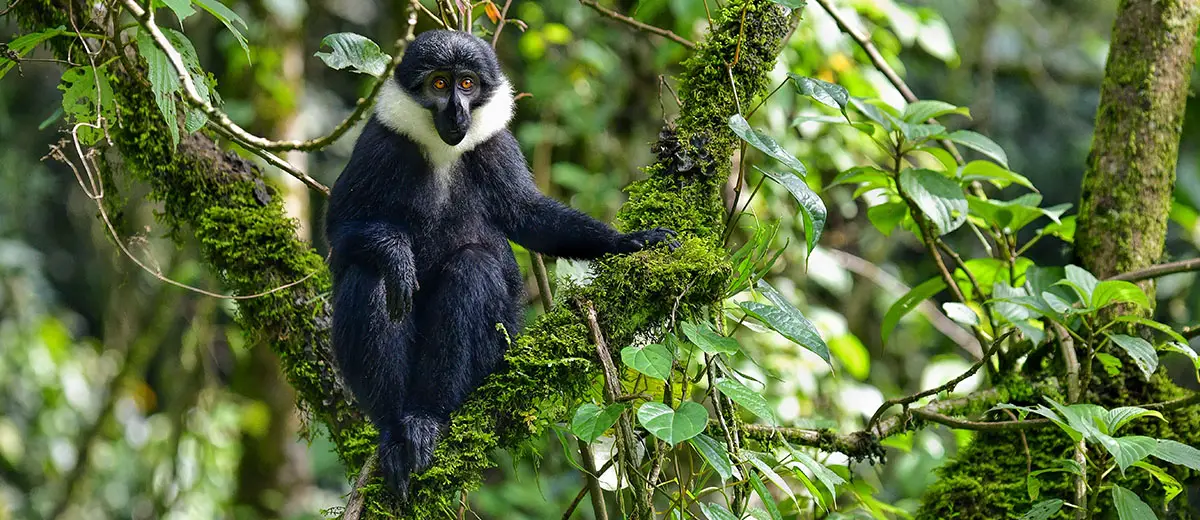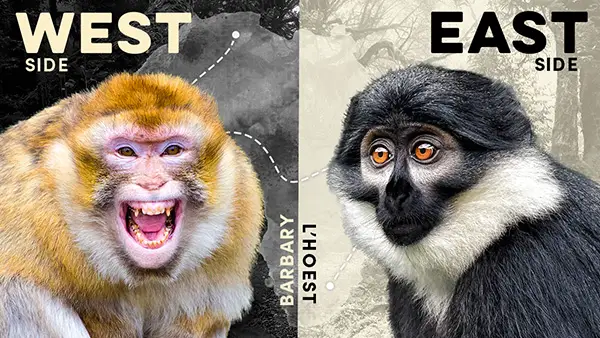13 Most Spectacular African Monkey Species (by Location)
Africa is home to a great number of the world’s most awe-inspiring creatures, yet amid the collection of classic safari animals, many of the continent’s most fascinating primates fall short of the limelight. From Morocco to Zanzibar and the Congo to the Cape, Africa plays host to over 70 species of monkeys, spread throughout its impressive array of habitats. In a previous video, we covered the fascinating world of baboons and mandrills so it is on this journey we’ll explore the smaller and more numerous species of African monkeys.
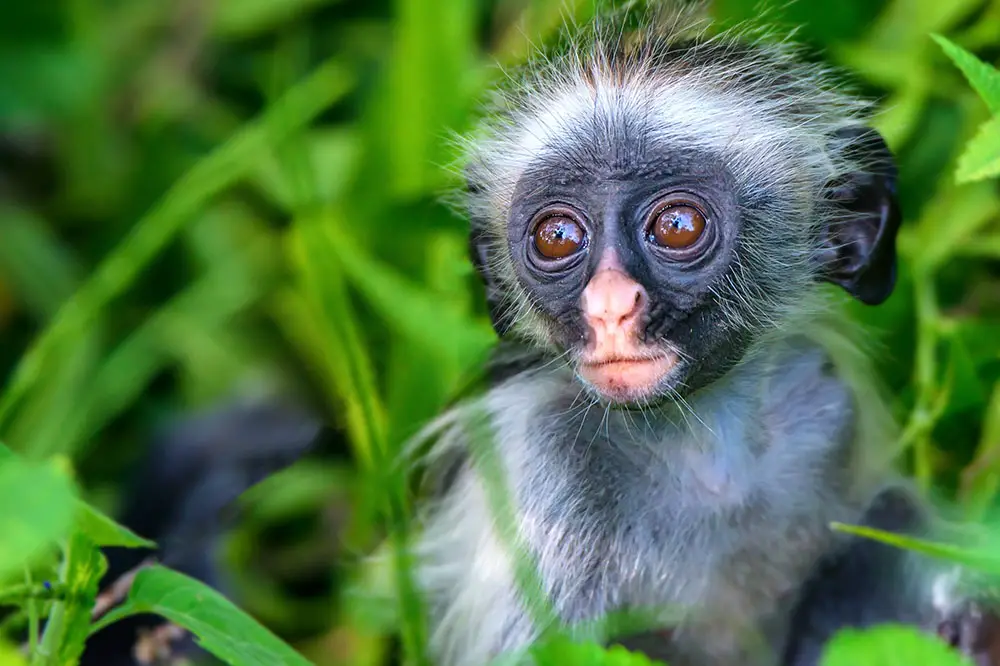
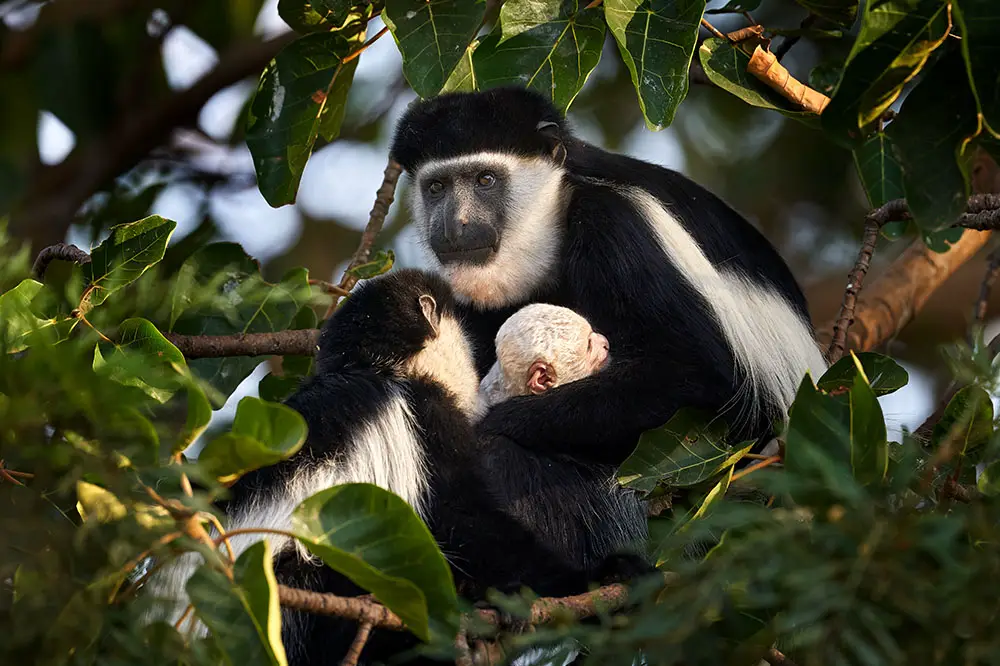
Left: Baby Zanzibar red colobus / Shutterstock & Right: Mantled guereza family with infant with white natal coat / Shutterstock
Contents
- Southern Africa
- Vervet | Chlorocebus pygerythrus
- East Africa
- Blue Monkey | Cercopithecus mitis
- Zanzibar Red Colobus | Piliocolobus kirkii
- Central Africa
- Mantled Guereza | Colobus guereza
- L’Hoest’s monkey | Allochrocebus lhoesti
- Wolf’s mona monkey | Cercopithecus wolfi
- De Brazza’s | Cercopithecus neglectus
- Talapoins | Miopithecus talapoin/ogouensis
- West Africa
- Collared Mangabey | Cercocebus torquatus
- Diana Monkey | Cercopithecus diana
- Western Red Colobus | Piliocolobus badius
- Patas Monkey | Erythrocebus patas
- North Africa
- Barbary Macaque | Macaca sylvanus
Southern Africa
There are few greater places to start our trip than Southern Africa. This diverse portion of the continent features not only an opportunity to see the big 5 but is home to one of the world’s largest salt flats, the 5th largest non-polar desert and several interesting monkey species.
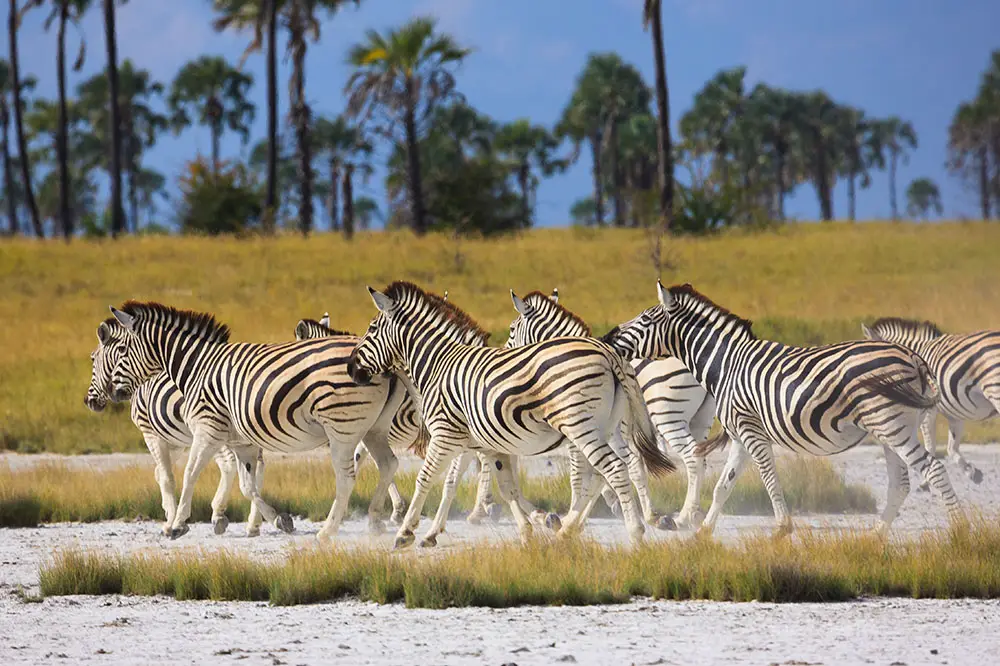
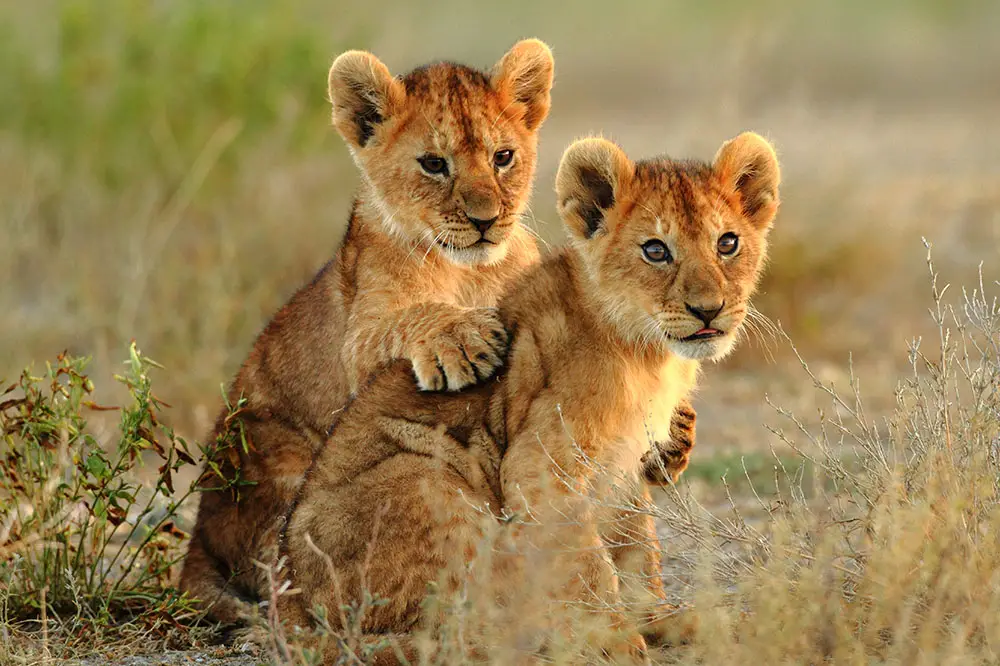
Left: Zebras in Makgadikgadi Pans National Park in Botswana / Shutterstock & Right: Lion cubs in Kruger National Park / Shutterstock
Vervet | Chlorocebus pygerythrus
Vervets are found mostly on the savanna where they navigate carefully to avoid leopards, birds of prey and even their fellow primates, yellow baboons. These monkeys are semi-terrestrial but at no more than 18 lbs (8.2 kg) trees play an important role in the life of the vervet, especially at night. Their most interesting physical characteristic is the bright blue scrotum of males, which is thought to be part of their sexual display with larger more vibrant scrota leading to a higher success rate. This is not an uncommon characteristic for old world monkeys with several other species also displaying colourful genitalia. Once mating has occurred, infants are born after 160 days or roughly 5 months and will grow up in a multi-male multi-female group numbering between 10 to 40 members. Males then leave their natal group upon maturity whereas females stay in theirs for life and will often inherit their place in the dominance hierarchy from their mother. Due to recent reclassification, the name vervet can either refer to the single species we’re currently discussing or to all of the members of its genus, which contains 6 very similar monkeys with a much wider combined distribution.
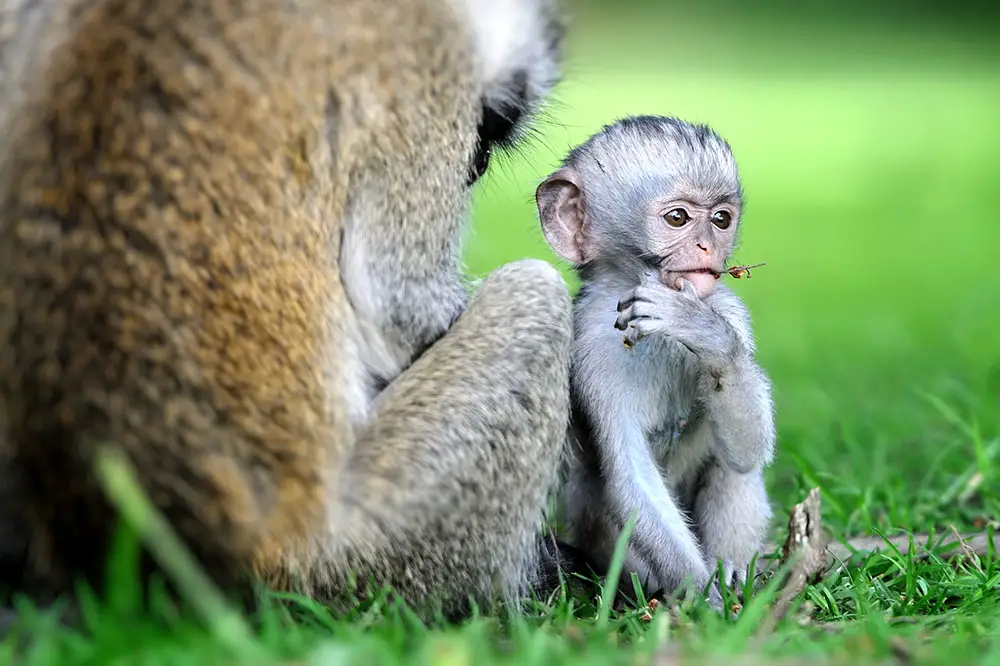
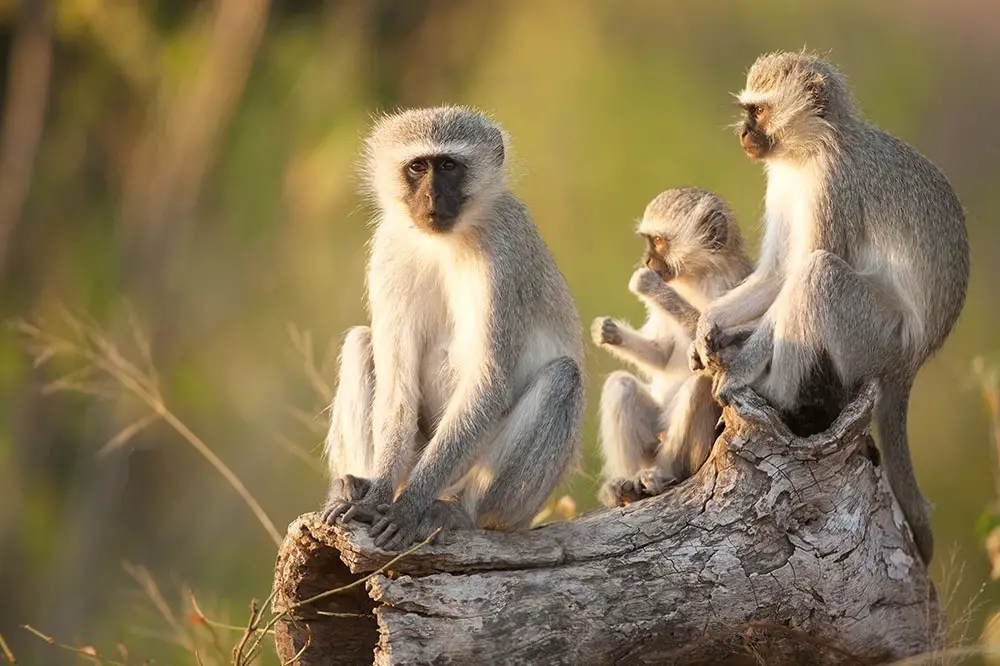
Left: Young vervet monkey / Shutterstock & Right: Group of vervet monkeys / Shutterstock
Surprisingly, aside from Chacma baboons and vervets, there are relatively few monkey species found in Southern Africa. One species whose range does overlap with that of the vervet, however, is the blue monkey, which is much more common in our next destination found to the north.
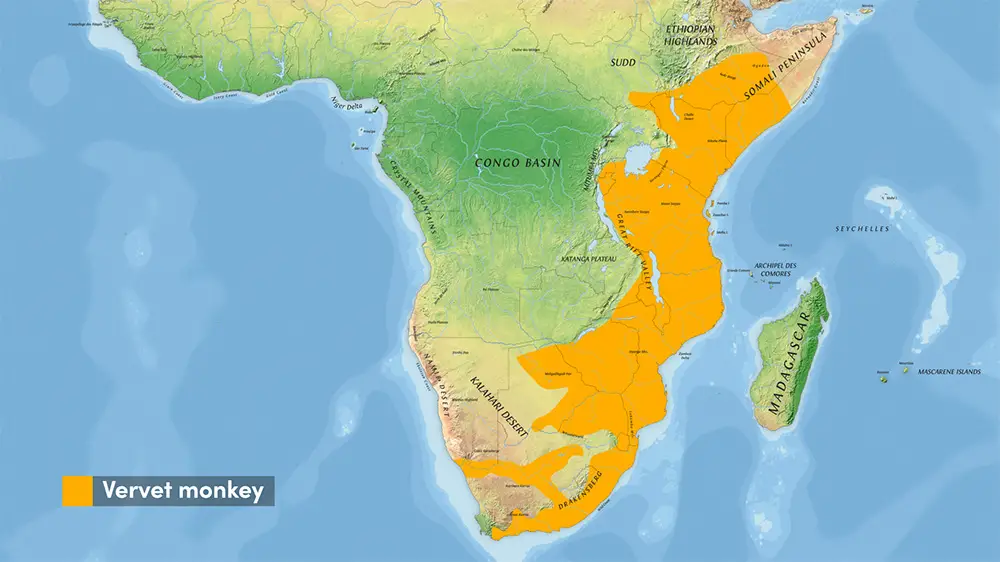
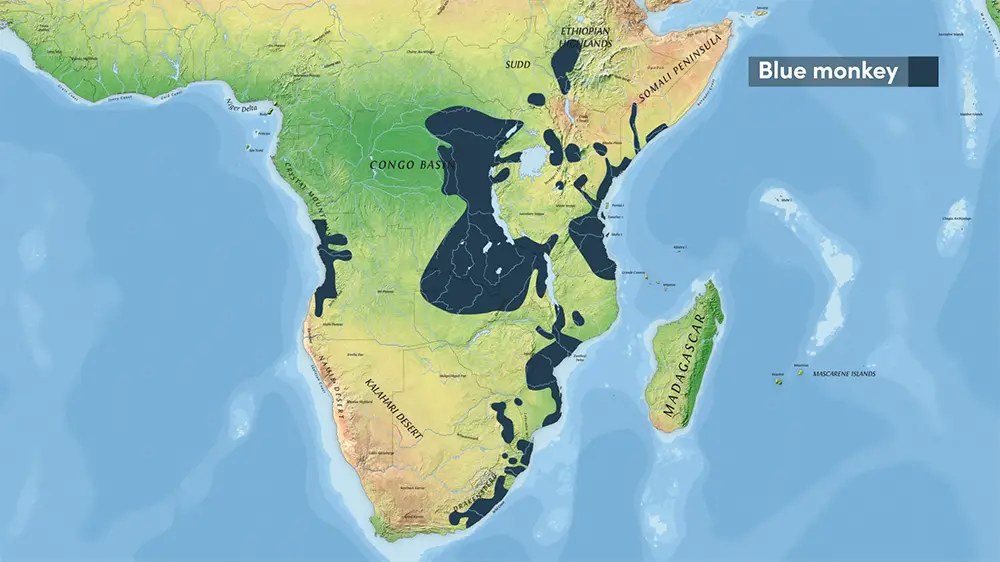
Left: Vervet range & Right: Blue monkey range
East Africa
East Africa is perhaps best known for the great migration, which takes place every year as millions of wildebeest and zebra trek in a loop between Kenya’s Massai Mara in the north and Tanzania’s Serengeti in the south in search of lush green grass. Although the savanna is the most well-known biome here, East Africa is also home to swaths of tropical forest and woodland, which are the perfect habitat for its spectacular arboreal monkey species.
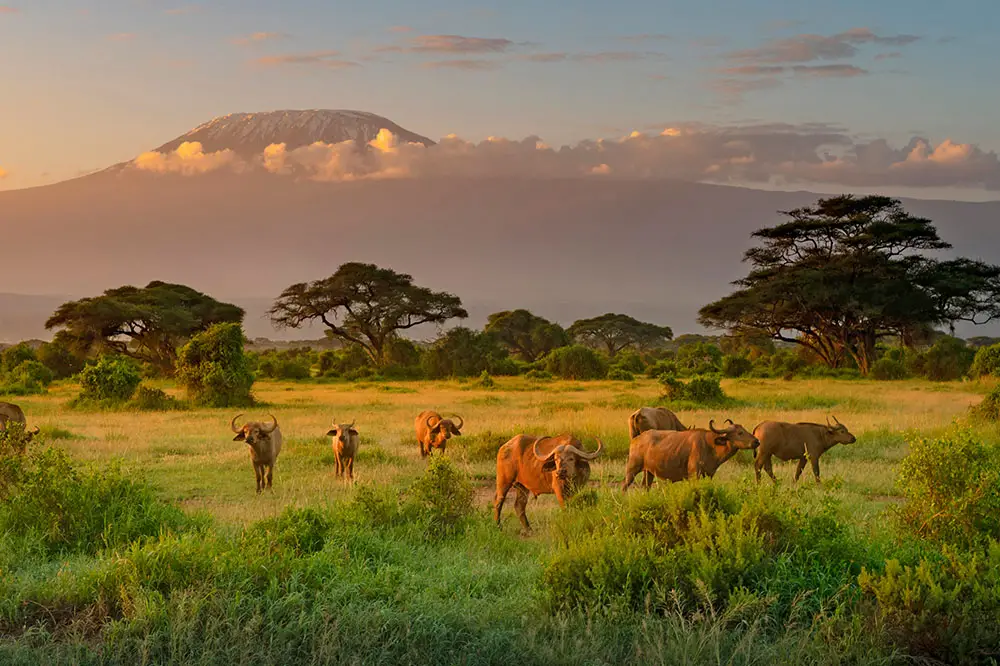
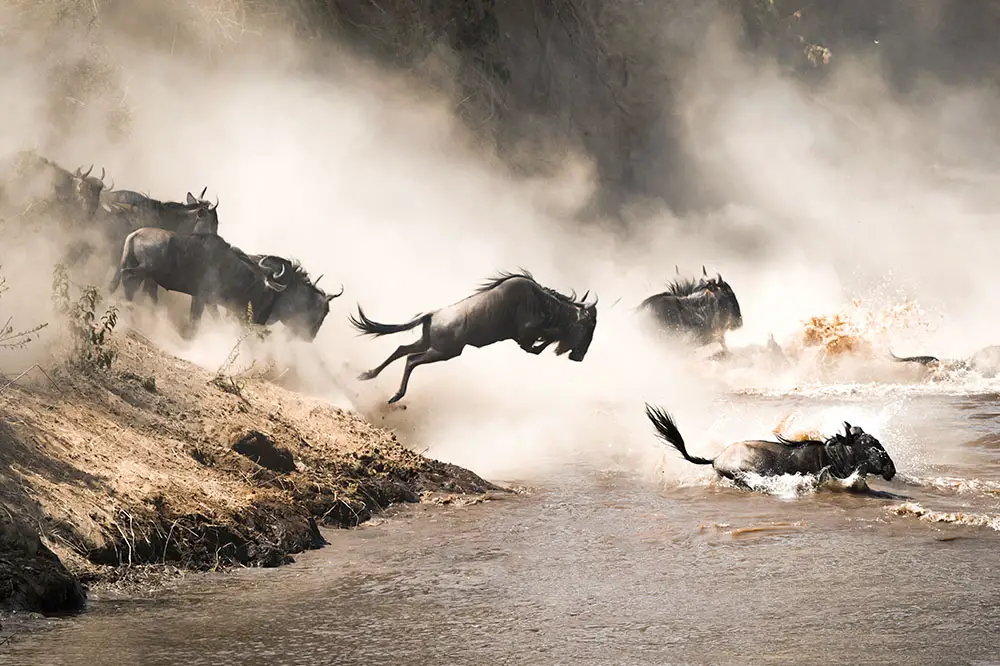
Left: Mount Kilimanjaro in morning light, Amboseli, Kenya / Shutterstock & Right: Wildebeest leaping into river during migration / Shutterstock
Blue Monkey | Cercopithecus mitis
To say the classification of the blue monkey is complicated would be an understatement. It is currently defined as one species with between 10-17 subspecies some of which are or have been referred to as Sykes monkeys, the Samango monkey, and other names but for the purpose of this video we’ll discuss them all as a single species, the blue monkey. It is these subspecies, however, that make this primate so interesting with noticeable differences in pelage; some individuals have a thick white collar line around their necks, which is present to a varying degree in others or not present at all. The brow band also varies from a distinct white line in some individuals to a more subtle colouration in others and the colour of the back ranges from a light grey to a reddish-brown that extends onto the top of the tail. These monkeys are referred to as arboreal guenons, a distinction we’ll explore later on in Central Africa, and are found high in the forest canopy where they feast on fruit, other vegetation and small mammals such as rodents and their fellow primates, galagos.
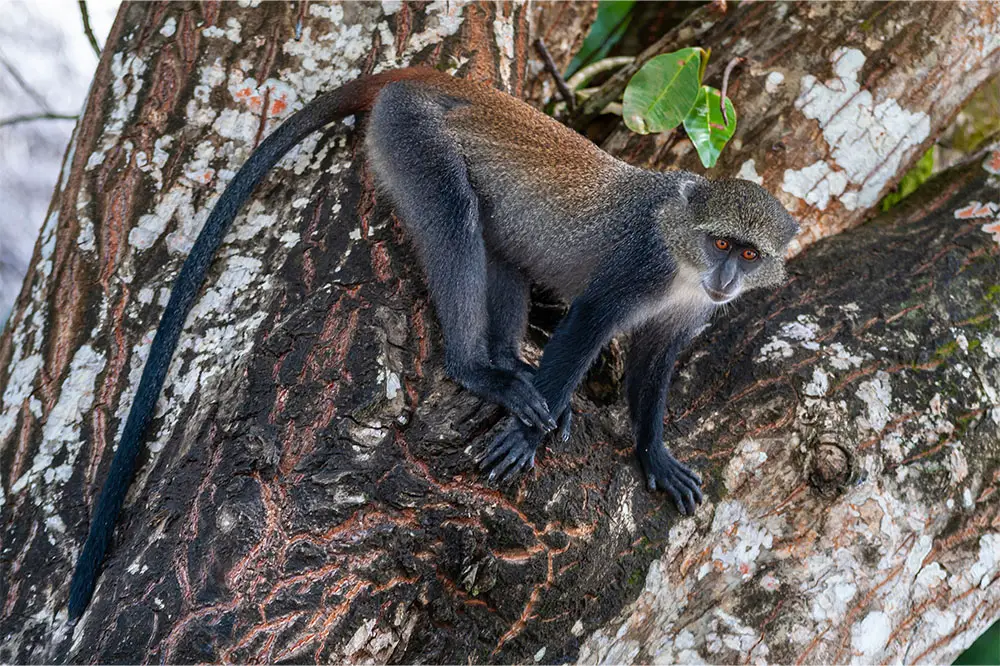
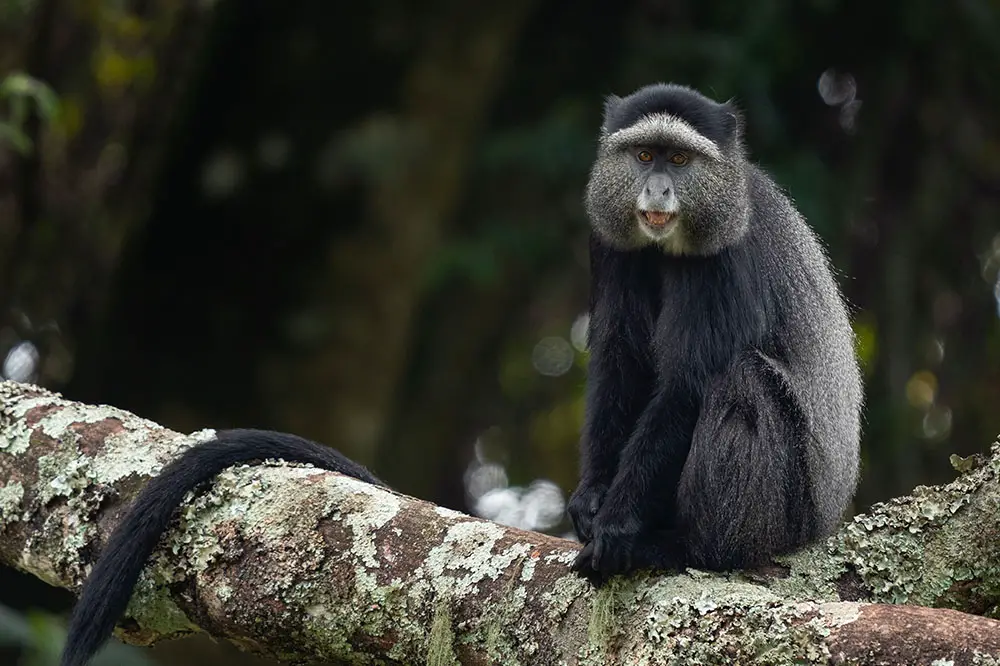
Left: Blue monkey in Jozani Forest in Zanzibar, Tanzania / Shutterstock & Right: Blue monkey in the Rwenzori mountains / Shutterstock
The range of the blue monkey extends onto an idyllic island found just 30 km (19 mi) off the Tanzanian coastline where we bump into a species indigenous to the island of Unguja, the largest of the Zanzibar archipelago and several neighbouring islands.
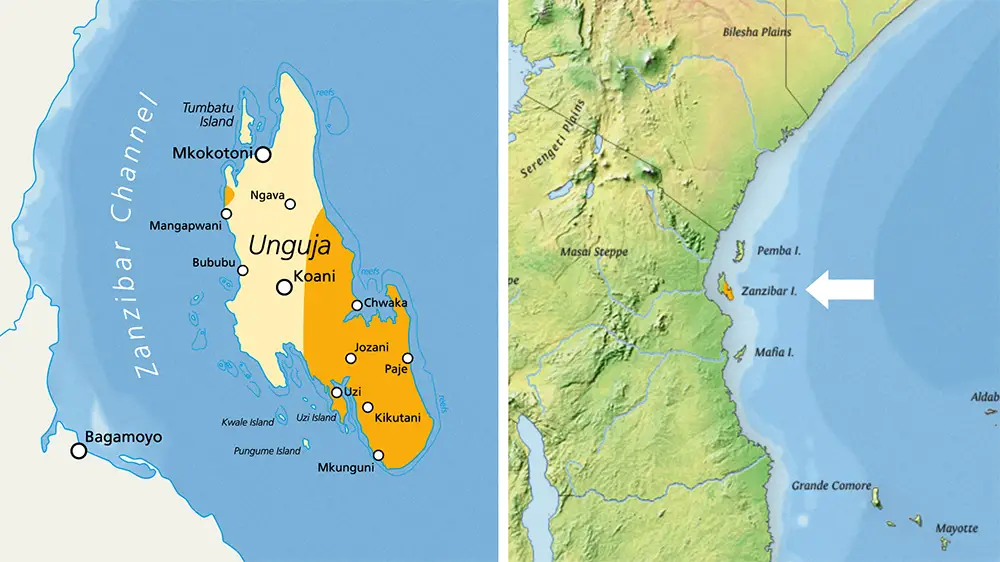
Zanzibar Red Colobus | Piliocolobus kirkii
The Zanzibar red colobus is quite different to the species previously discussed. Their skin is mostly black with lighter areas present around the nose and mouth and sometimes on the nipples and the soles of the feet. Their characteristic red pelage, which is present on the dorsal side of their bodies and tail, develops with age; Infants are born with only black and white hair, which transitions to a deep red colour between 3 to 11 months of age. Found mostly in scrub forests and mangrove swamps, their diet is made up mostly of leaves, which they supplement with fruit and to a lesser degree, flowers, buds and other types of vegetation. These monkeys are unfortunately classified as endangered, which was supported by a fascinating 2017 study which found there to be just under 6,000 individuals in the wild split between 342 groups. This puts the average group size at 17 members. Of the 6,000 individuals, 54% were adult females or 9 per group (9.29), 16% were adult males, roughly 3 per group (2.71) another 16% were infants (2.71) and 13.5% were sub adults or juveniles, which is closer to 2 per group (2.32). All red colobuses are part of the same genus, Piliocolobus, which is part of a group that also contains olive colobuses and black and white colobuses, including the Mantled Guereza.
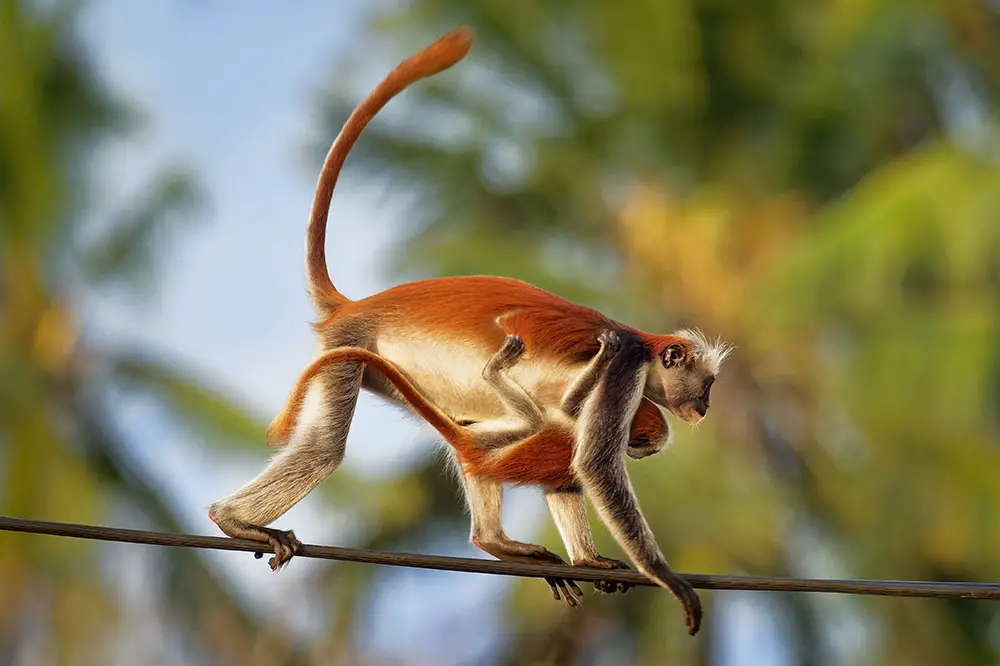
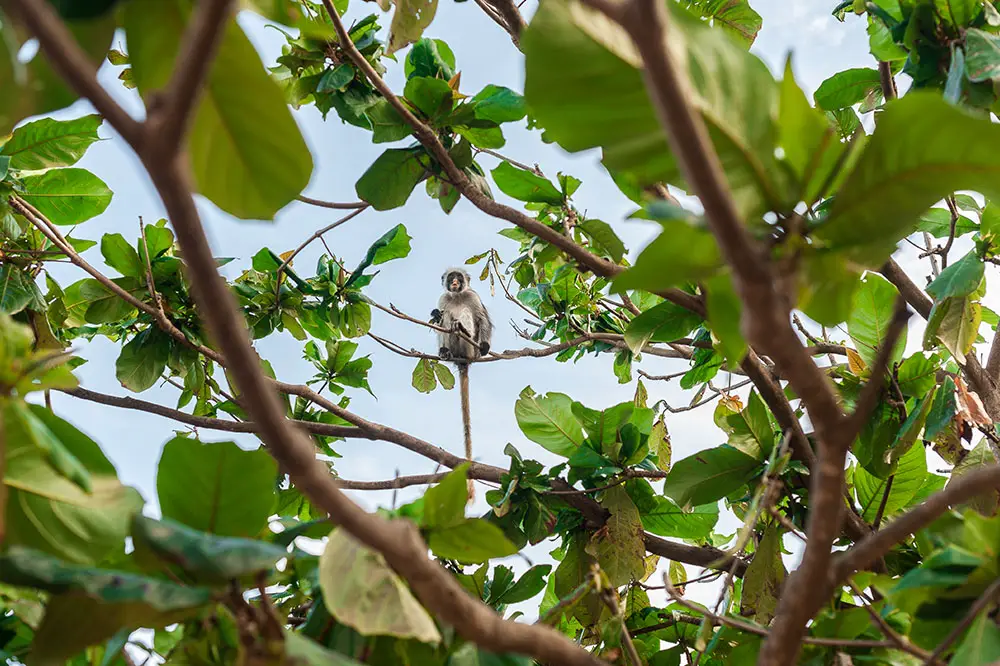
Left: Mother and infant Zanzibar red colobus / Shutterstock & Right: Zanzibar red colobus through the canopy / Shutterstock
To visit this species, we need to head back to the mainland and prepare ourselves for the longest portion of the trip, exploring the monkeys of the Congo.

Central Africa
There are few areas of the world more adventurous than Central Africa. This tropical region sits on the equator where its geography is dominated by the great Congo River, which boasts the second largest drainage basin in the world. The rainforests of the Congo contain some of the world’s lesser known and more peculiar animals.
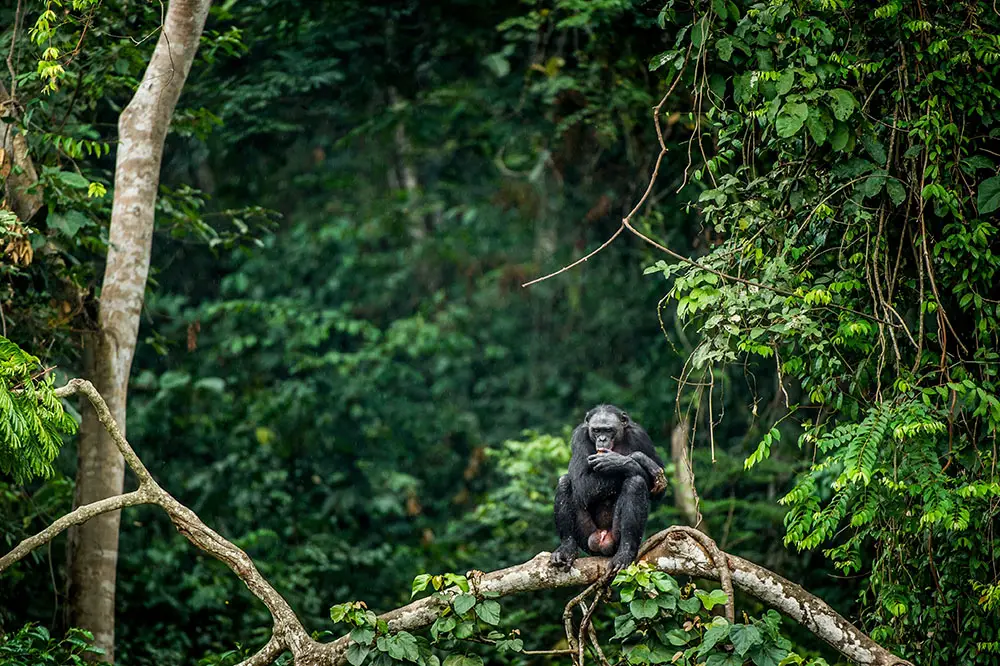
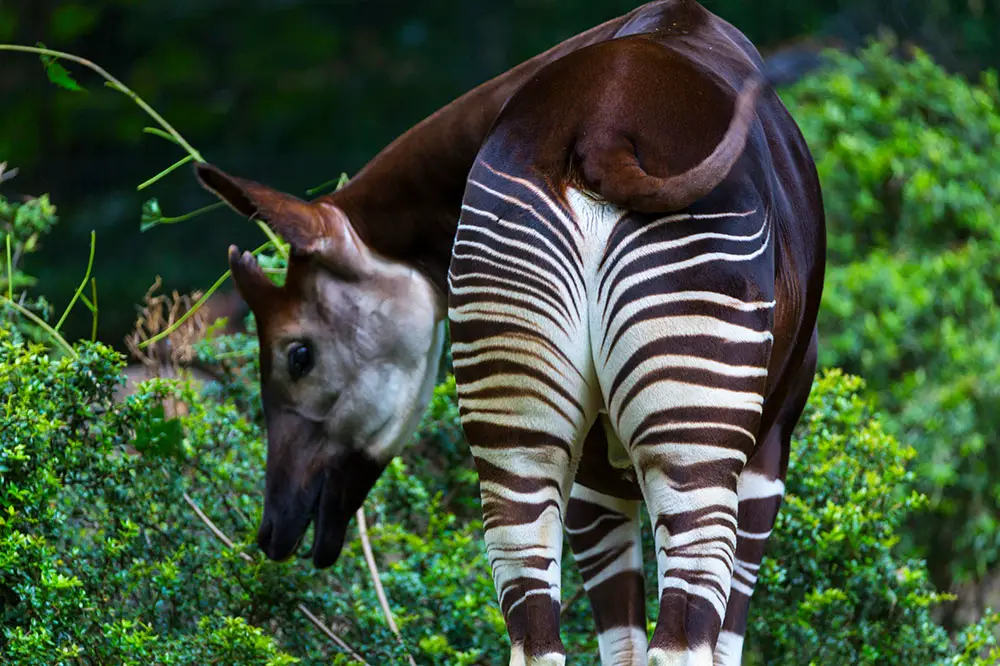
Left: Bonobo in the Democratic Republic of Congo / Shutterstock & Right: The Okapi, native to northeastern DRC / Shutterstock
Mantled Guereza | Colobus guereza
The Mantled Guereza, also known as the eastern black-and-white colobus, is named so for its long cloak-like mantle, which begins in black and transitions to white as it drapes across the sides of the body. Their tail is also a distinguishing feature with a large, white tuft towards the end. Although this adult pelage is impressive, one of their most interesting traits is the natal coat of infants, which is short and entirely white and begins to transition to black after just a few weeks. At 175 days, gestation is a little longer than the vervet monkey and the single offspring is cared for by both the male and female. Group size is quite small, usually numbering no more than 15 members which contains just one adult male, with his male offspring leaving the group upon maturity.
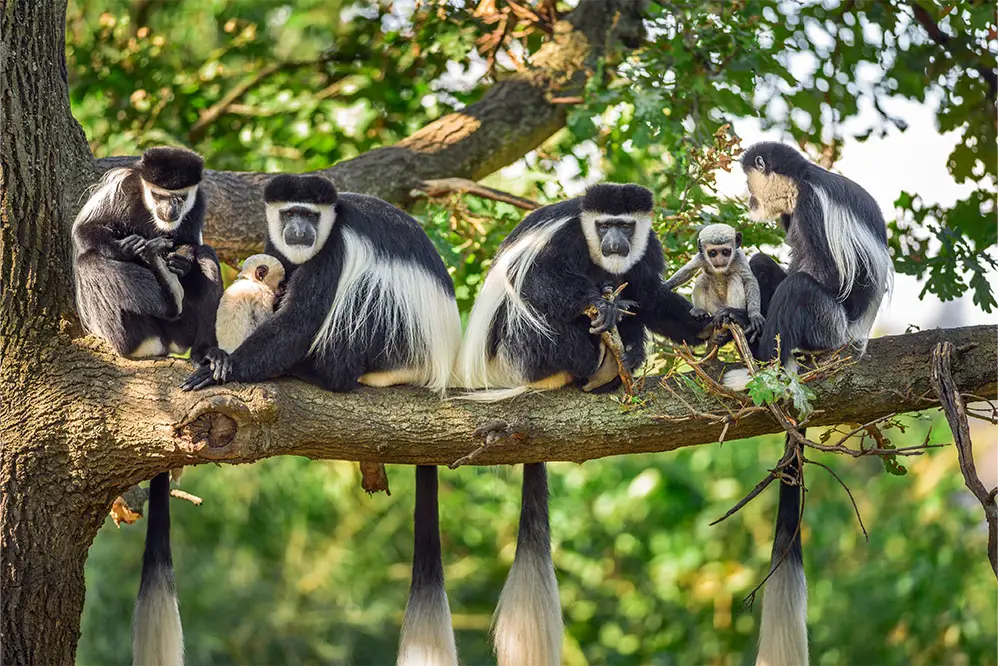
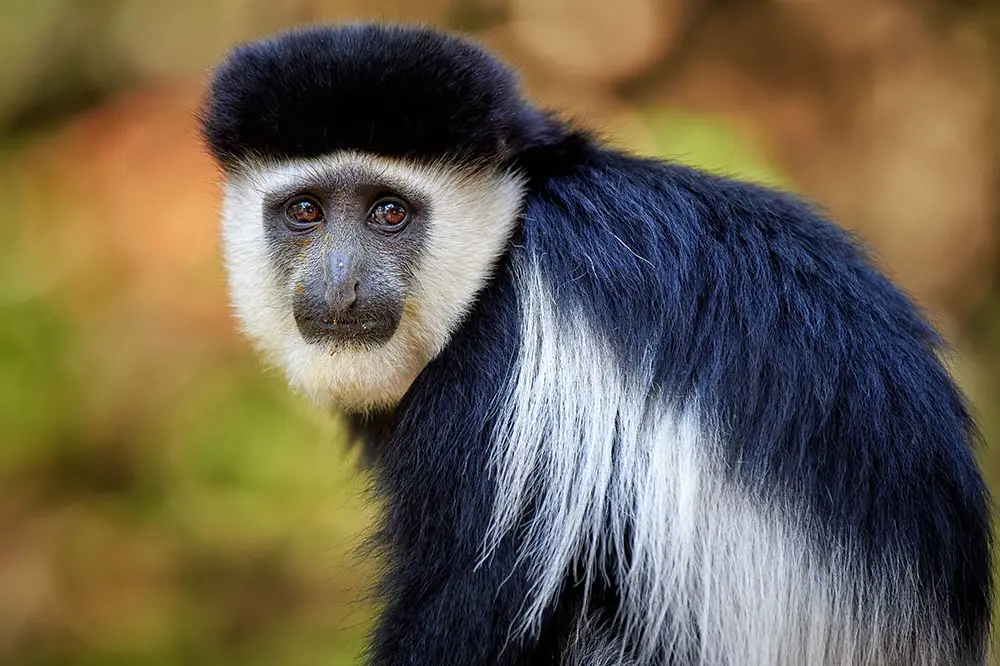
Left: Group of mantled guereza with infants / Shutterstock & Right: Mantled guereza profile / Shutterstock
The next species on our journey has a much smaller range, being found only on the eastern side of Central Africa at elevations between 3,000 and 8,000 ft (900 to 2,500 m).
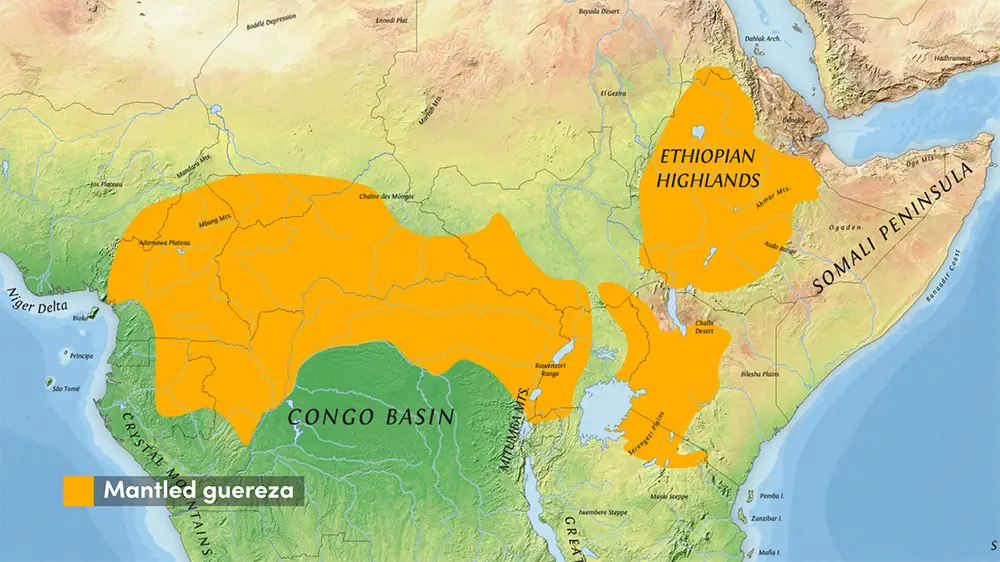
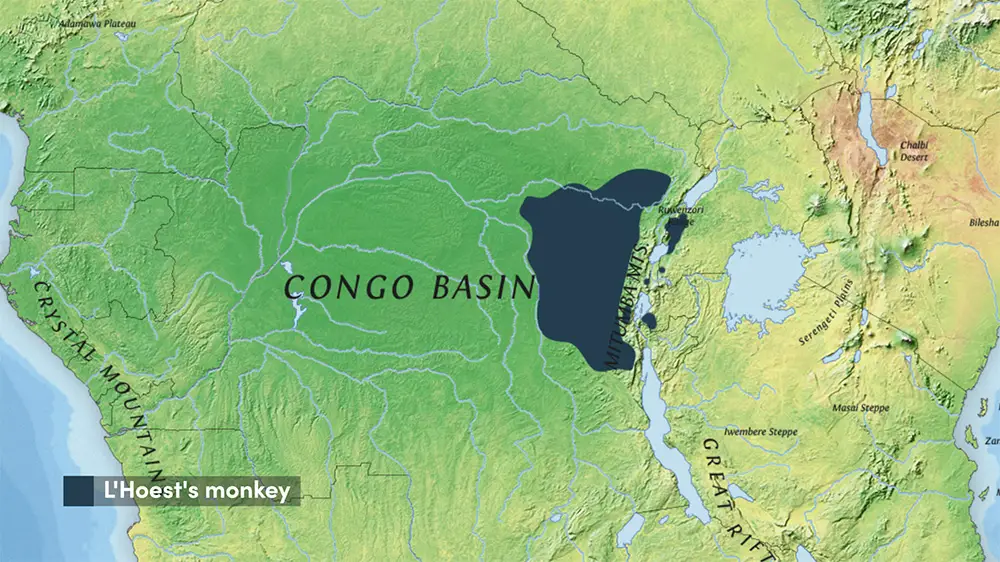
Left: Range of the mantled guereza & Right: Range of L’Hoest’s monkey
L’Hoest’s monkey | Allochrocebus lhoesti
L’Hoest’s monkey, also known as the mountain monkey, is found in montane tropical forests and is quite striking with jet black fur, which is broken by a large white collar around the neck, an area of chesnut-coloured hair on the back and a lighter section on the top of their long tails. At no more than 13 lb (6 kg / 13.22 lb) they are not particularly large and are sometimes preyed upon by chimpanzees and birds of prey. L’Hoest’s monkeys are referred to as terrestrial guenons spending most of their time on the ground hunting for invertebrates, which can make up between 10-50% of their diet. There are only three species of terrestrial guenon, a number that is dwarfed by the 20+ arboreal guenons, including the previously discussed blue monkey and our next colourful Congolese species.
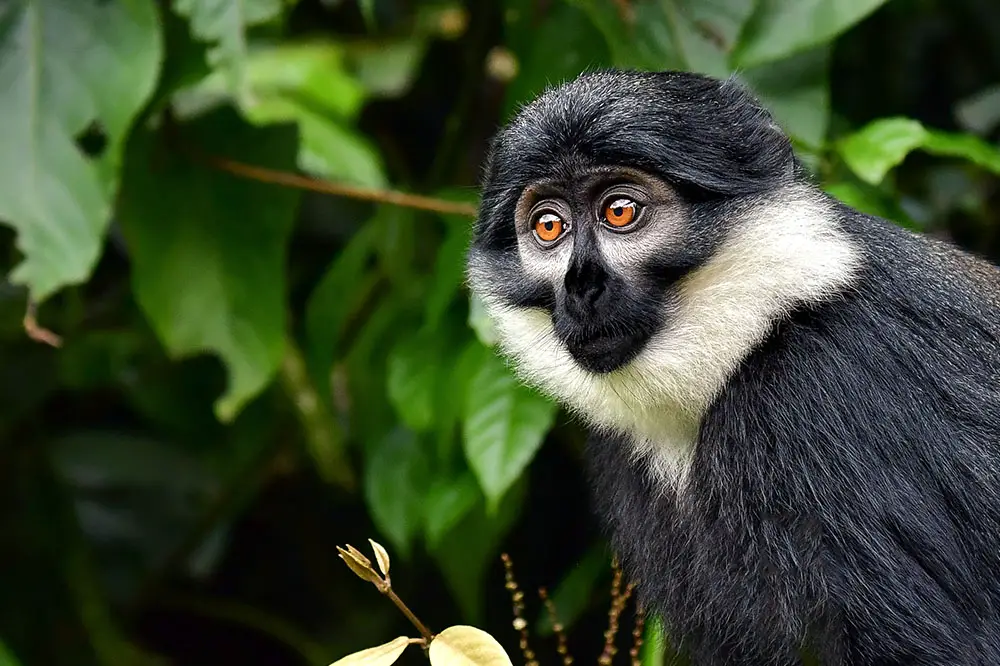
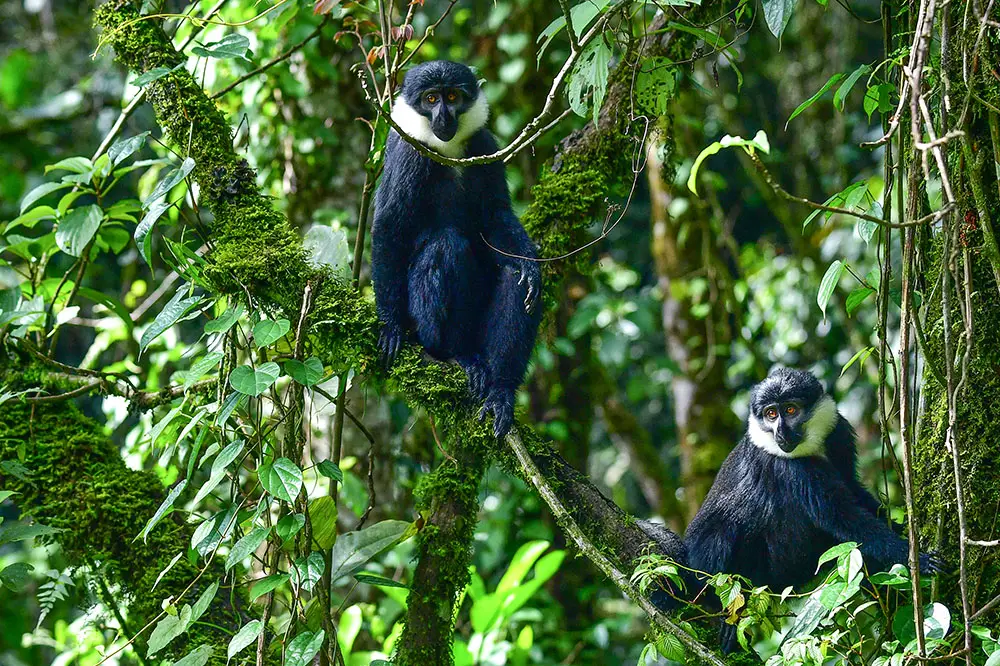
Left: L’Hoest’s monkey profile / Shutterstock & Right: L’Hoest’s monkeys in the rainforest / Shutterstock
Wolf’s mona monkey | Cercopithecus wolfi
Wolf’s mona monkey is by far my favourite African monkey and, unfortunately, has a conservation status of near threatened and only a few available photos. Regardless, they exhibit vibrant golden-yellow hair on their legs, which bleeds onto the underside of their belly and has matching bright yellow ears and faded yellow cheeks. One of their most interesting behavioural traits is their tendency to exist in multi species groups, most commonly associating with black mangabeys and other species such as red-tailed guenons.
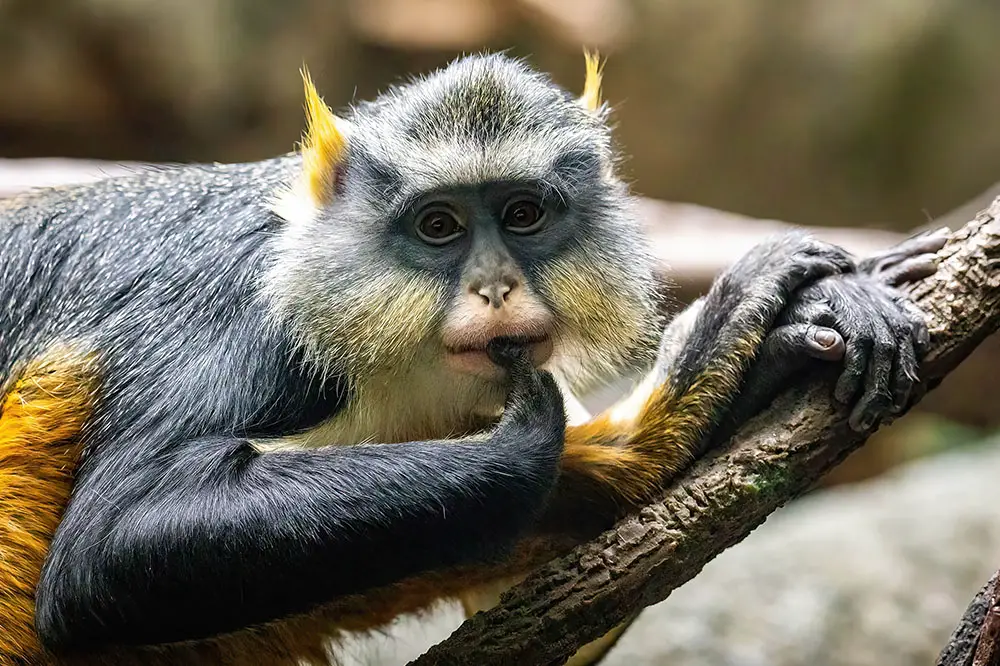
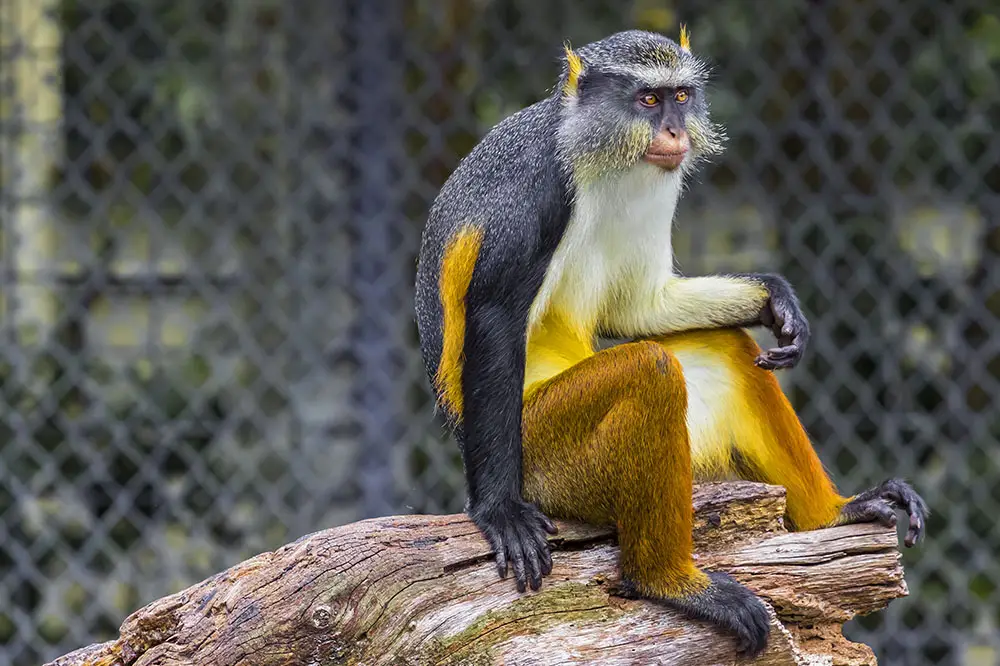
Left: Wolf’s mona monkey portrait / Shutterstock & Right: Wolf’s mona monkey with bright yellow legs / Shutterstock
These monkeys are found on the western side of this region and share their range with another colourful guenon, found to the north.
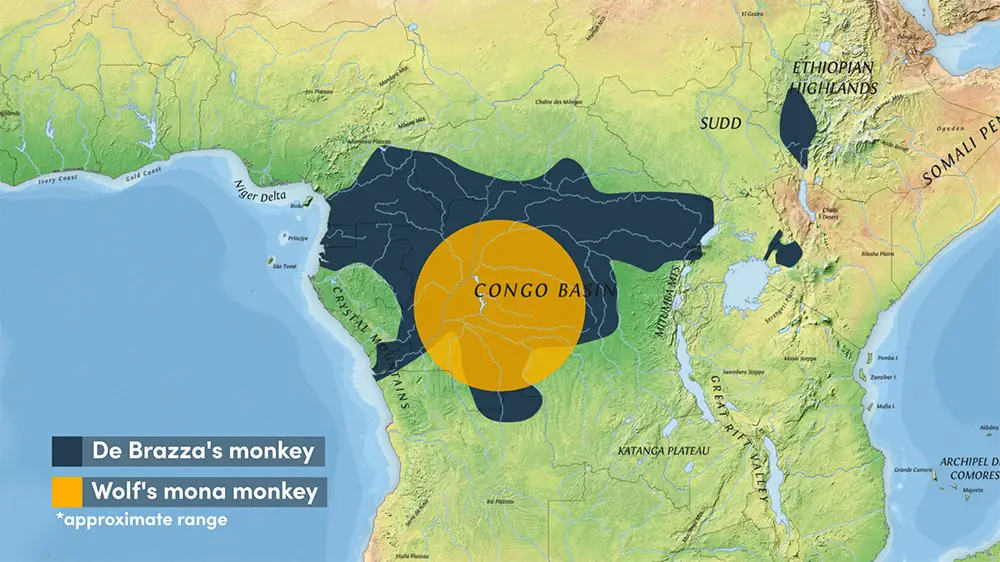
De Brazza’s | Cercopithecus neglectus
De Brazza’s monkeys are especially unique and interesting for two reasons. The most obvious being their orange brow line, which is present to a much lesser degree in infants and becomes more defined with age. The less obvious being their group structure; although they are most commonly found in small one-male units numbering no more than 10, these monkeys have been observed, specifically in Gabon, in monogamous pairs, which is uncommon for non-human primates but is a trait exhibited by gibbons in Asia and titi monkeys in the New World. De Brazza’s monkeys are highly sexually dimorphic with males weighing up to 15.4 lb (7 kg) and females not far off half at no more than 9 lb (4 kg / 8.8 lb), which is still over double the weight of our next species.
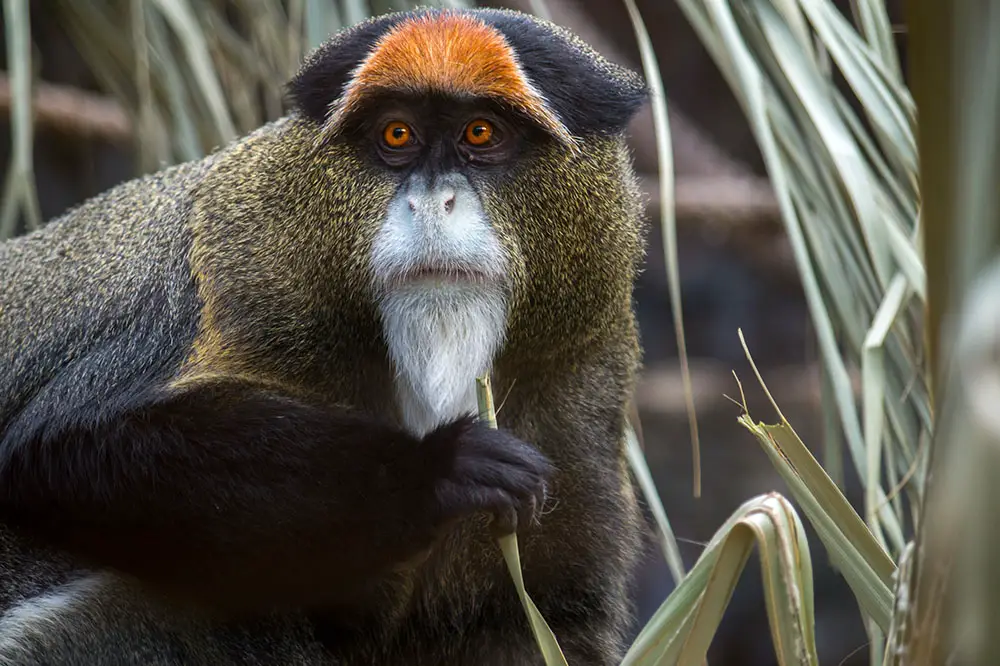
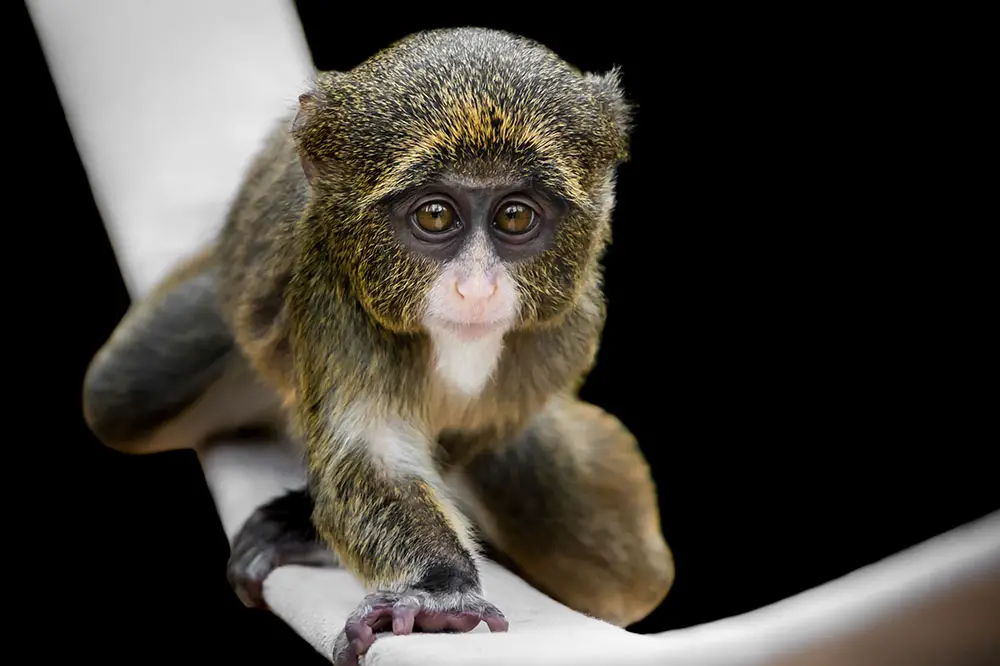
Left: Adult De Brazza’s monkey / Shutterstock & Right: Baby De Brazza’s Monkey / Shutterstock
Talapoins | Miopithecus talapoin/ogouensis
At little over 4 lbs (1.9 kg / 4.2 lb) talapoins are the smallest Old World monkeys. For reference, the smallest monkey on earth is the New World’s pygmy marmoset, which is, almost unbelievably, just a touch over 4 oz (124 g / 4.37 oz), or 15 times smaller than a talapoin! The largest monkeys are mandrills, which have been recorded up to 119 lbs (54 kg) or 435 times the size of a pygmy marmoset! There are two species of talapoin, which are difficult to distinguish visually so for the purpose of this video, we’ll discuss them together. Although these relatively small monkeys would be difficult to spot individually, they are commonly found in large groups numbering up to 100 individuals, which help protect them from predators such as Nile monitors or one of the many African cats. Like many species of monkey, females develop a swelling of the perineum during estrus, which signals to males she is ready to mate. Gestation is around 160 days and infants, who weigh just a few ounces at birth (50 – 80 g), develop rapidly once born.
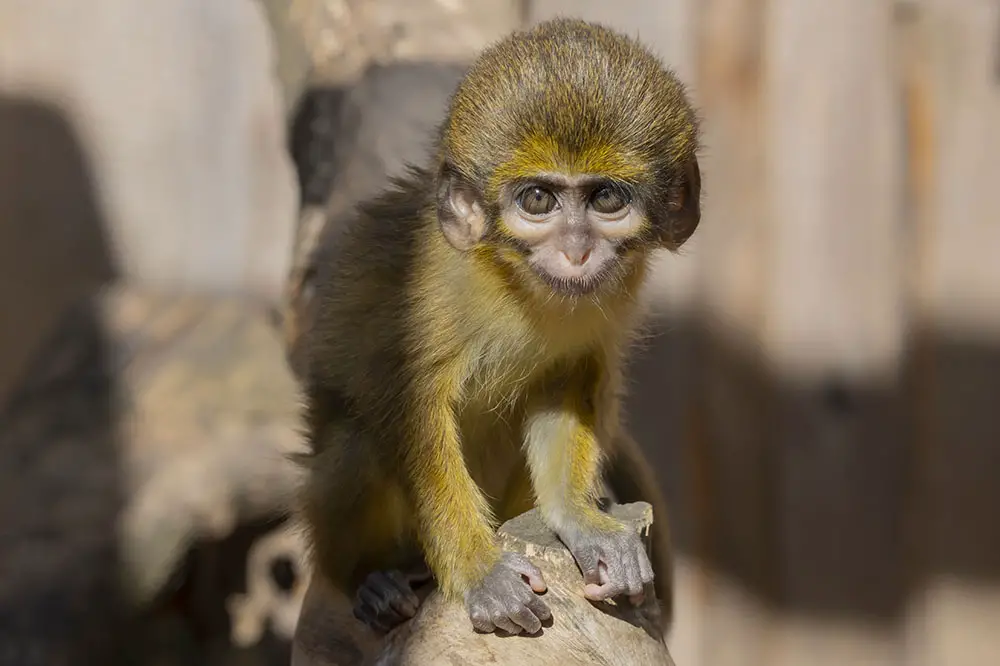
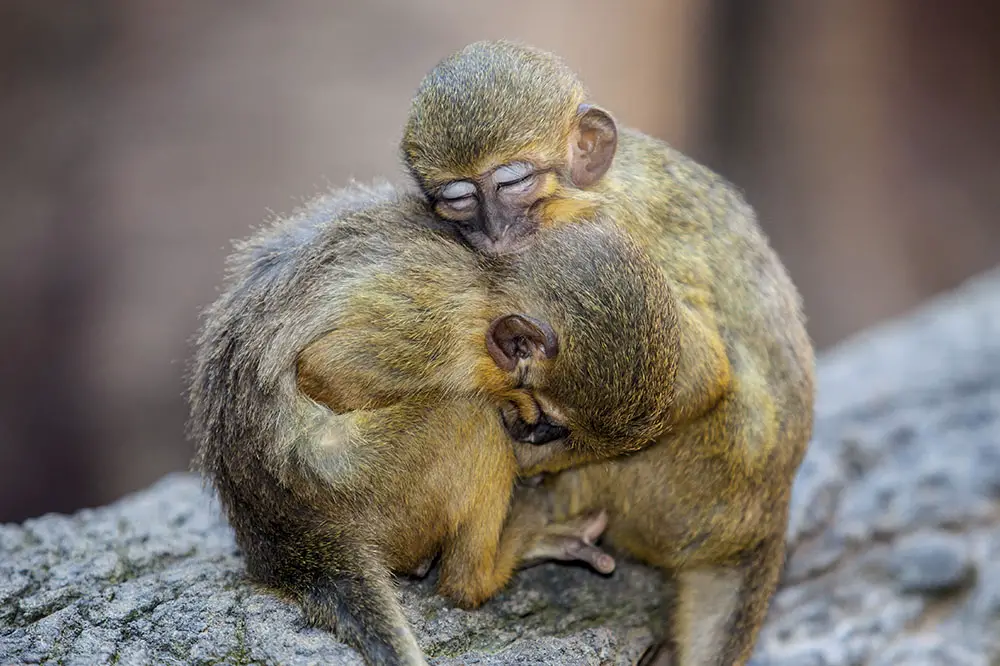
Left: Baby Gabon talapoin / Shutterstock & Right: Pair of Gabon talapoins sleeping / Shutterstock
The two species are also referred to as northern and southern talapoins; due to their ranges being split by the Congo river with that of the Gabon talapoin coming very close to entering our next destination found to the north.
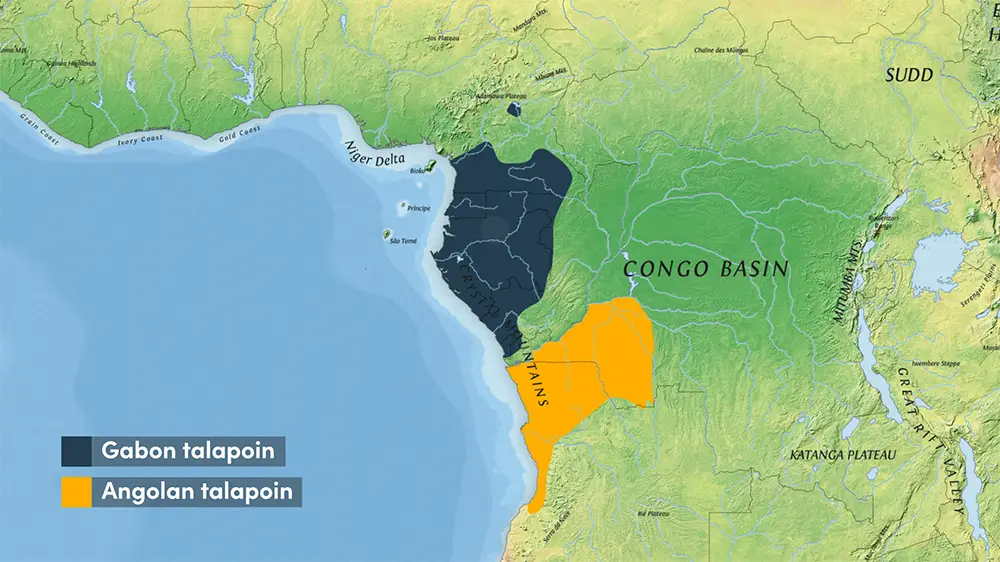
West Africa
West Africa is another unique region featuring a diverse collection of habitats; a band of tropical forest hugs the coastline followed by a large expanse of tropical grassland underneath the Sahara. The species-rich rainforests of West Africa stretch from The Gambia and Senegal in the west, through Sierra Leone and Liberia and into Nigeria in the eastern portion of the region and play host to some of the most interesting African monkeys.
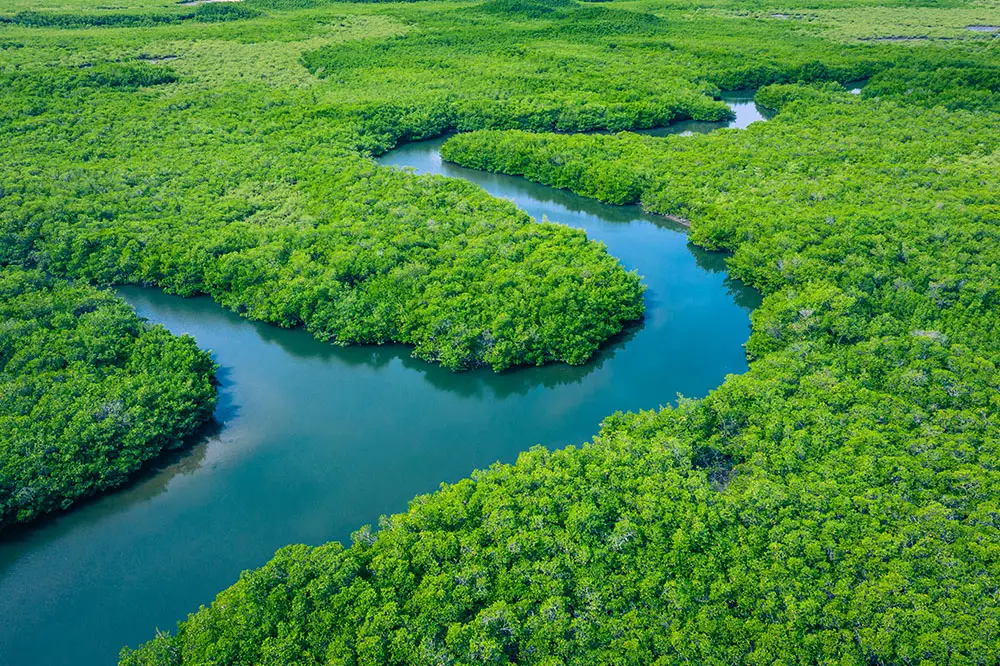
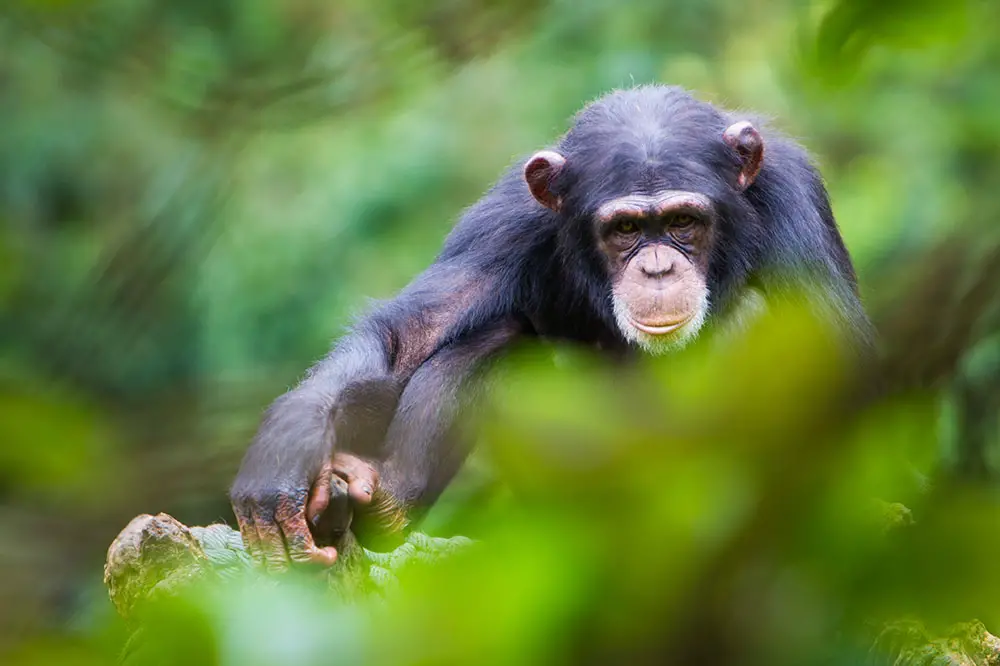
Left: Aerial view of mangrove forest in Gambia / Shutterstock & Right: Chimpanzee in Sierra Leone / Shutterstock
Collared Mangabey | Cercocebus torquatus
The red-capped mangabey is one such species, and is contained in a genus whose members are referred to as the white-eyelid mangabeys. Although these monkeys are thought of as arboreal, they are more than comfortable on the forest floor, fleeing from predators more often in this environment. Like many species on this list, red-capped mangabeys have cheek pouches, which allow them to store food during collection and consume it later on; as omnivores, they feast on fruit, nuts, leaves and other vegetation in addition to invertebrates.
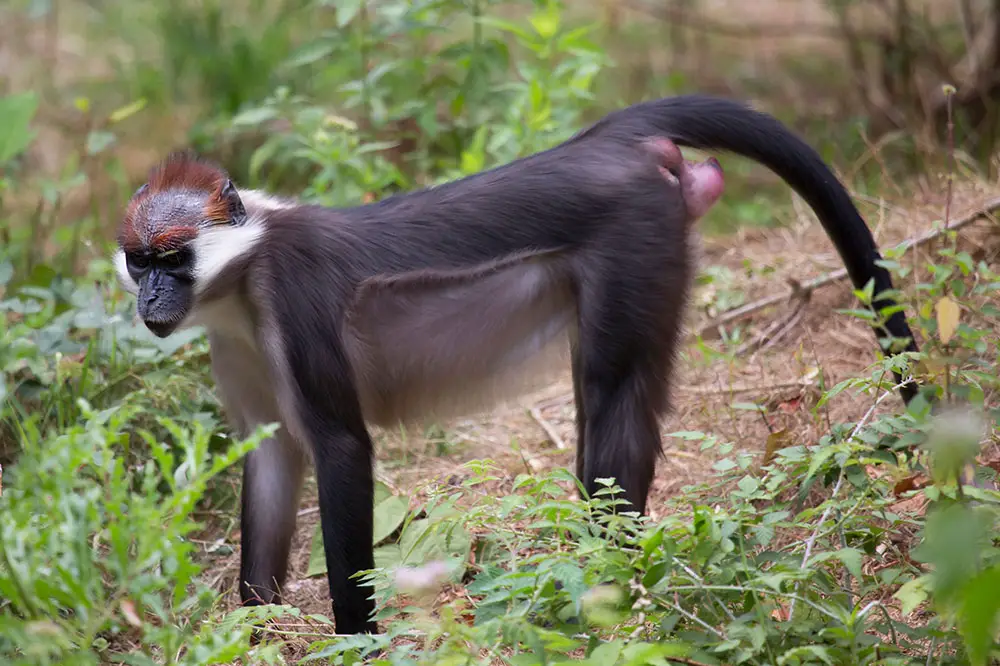
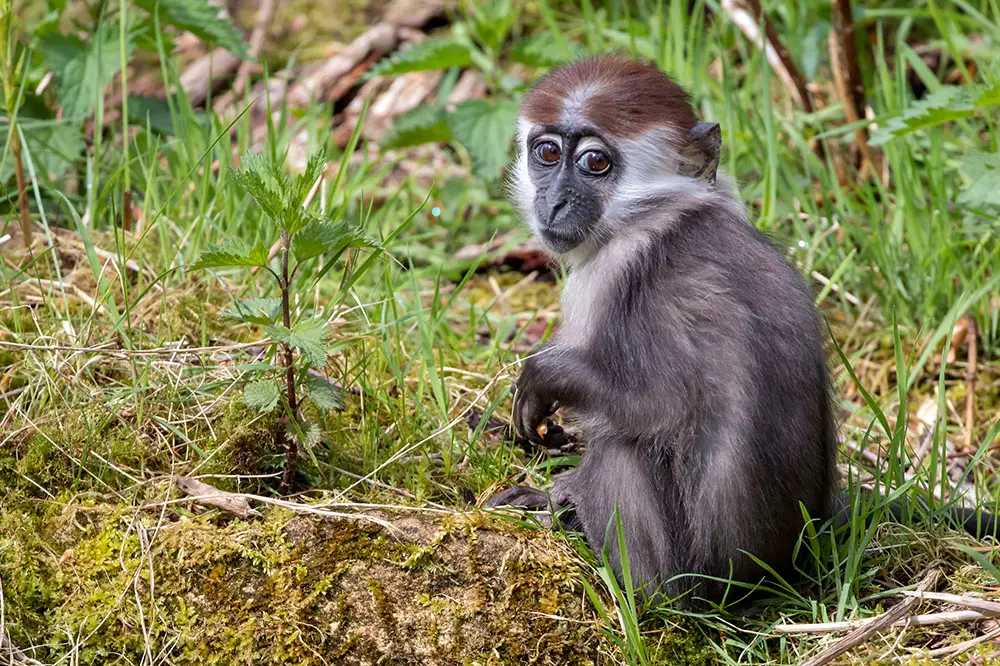
Left: Red-capped or collared mangabey / Shutterstock & Right: Young collared mangabey foraging for food / Shutterstock
Their range stretches from Central Africa, around the Gulf of Guinea and terminates in Nigeria where we hop two countries to visit our next monkey in Ghana.
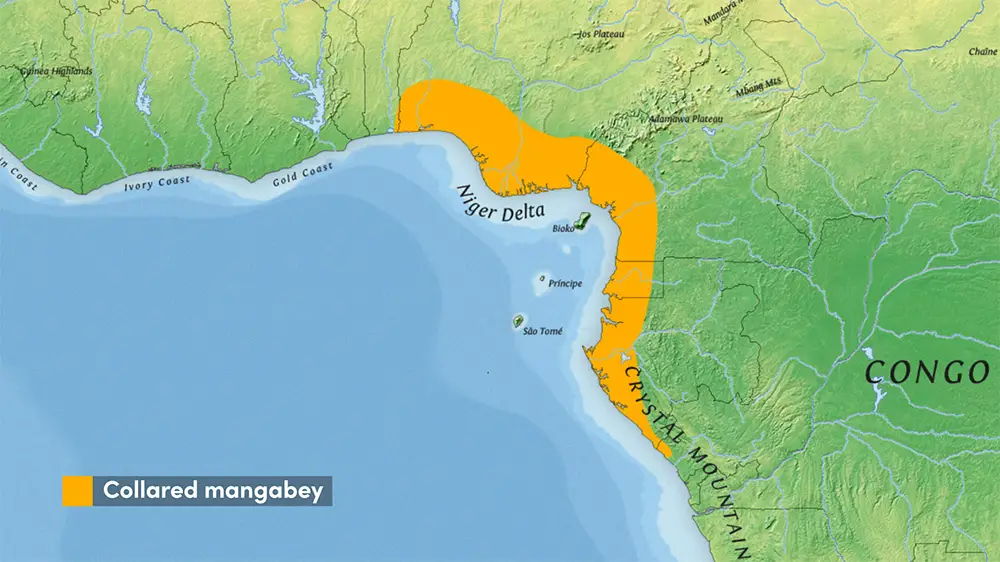
Diana Monkey | Cercopithecus diana
The Diana monkey is another arboreal guenon, which, in addition to its striking white chest, is deceptively colourful depending on your angle of sight. On the dorsal side, the area from the base of the tail to the upper back is a deep red colour and the backs of the legs a vibrant orange colour. These monkeys are medium in size, with males weighing no more than 15.5 lb (7 kg). There is one other species of guenon that looks almost identical to the Diana monkey but with a noticeably longer beard; at one point, the roloway monkey was considered a subspecies of Diana but has since been given full species status and the two are split geographically, with the roloway to the east and the Diana to the west, which has an almost identical range to another species of red colobus.
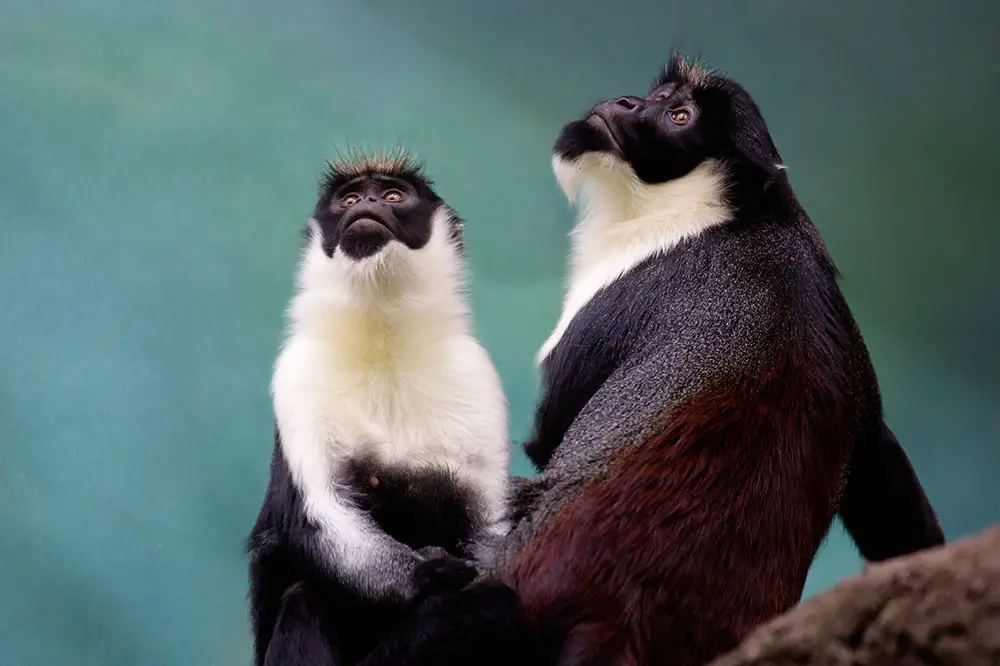
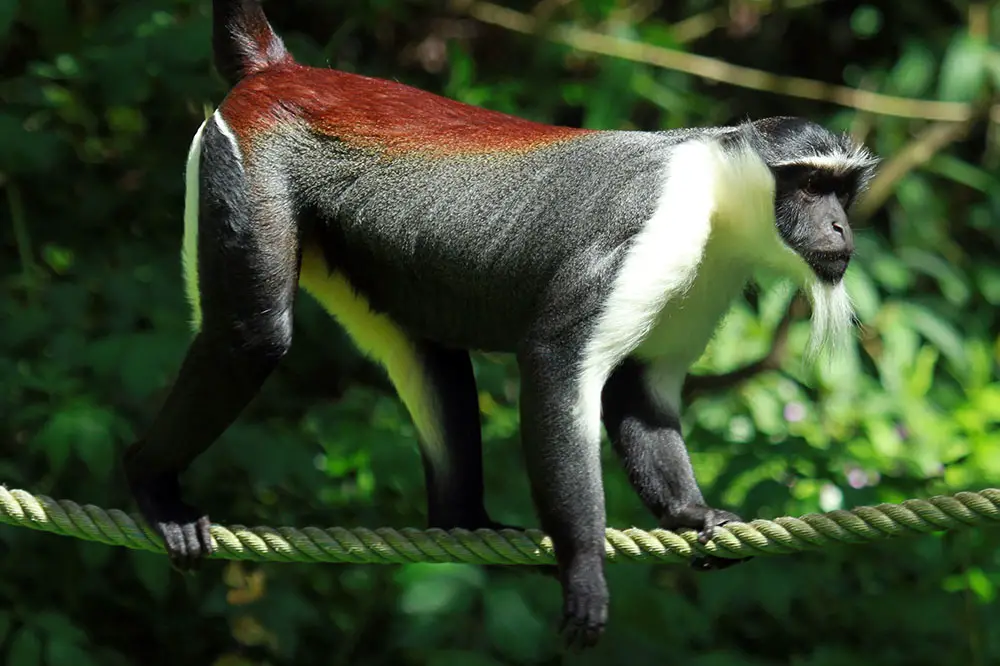
Left: Pair of Diana monkeys / Shutterstock & Right: Roloway monkey / Shutterstock
The two are split geographically, with the roloway to the east and the Diana to the west, which has an almost identical range to another species of red colobus.
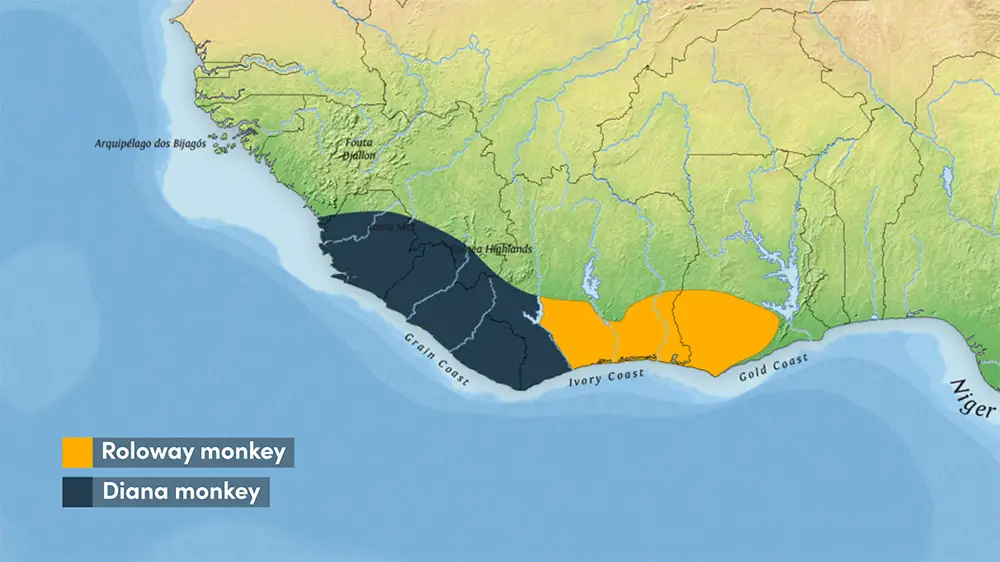
Western Red Colobus | Piliocolobus badius
The Western Red Colobus is from the same genus as its Zanzibar cousin and, although the pelage is quite different, also has lighter skin around the nose and mouth. These monkeys are almost strictly arboreal, being found high up in the forest canopy and rarely descend to the forest floor. They live in large multi-male multi-female groups numbering between 20 to 80 individuals but unlike some of the species we’ve explored it is the females that leave the natal group and males that remain in theirs for life. These monkeys are hunted both by chimpanzees and leopards as well as being part of the bushmeat trade and are currently listed as endangered.
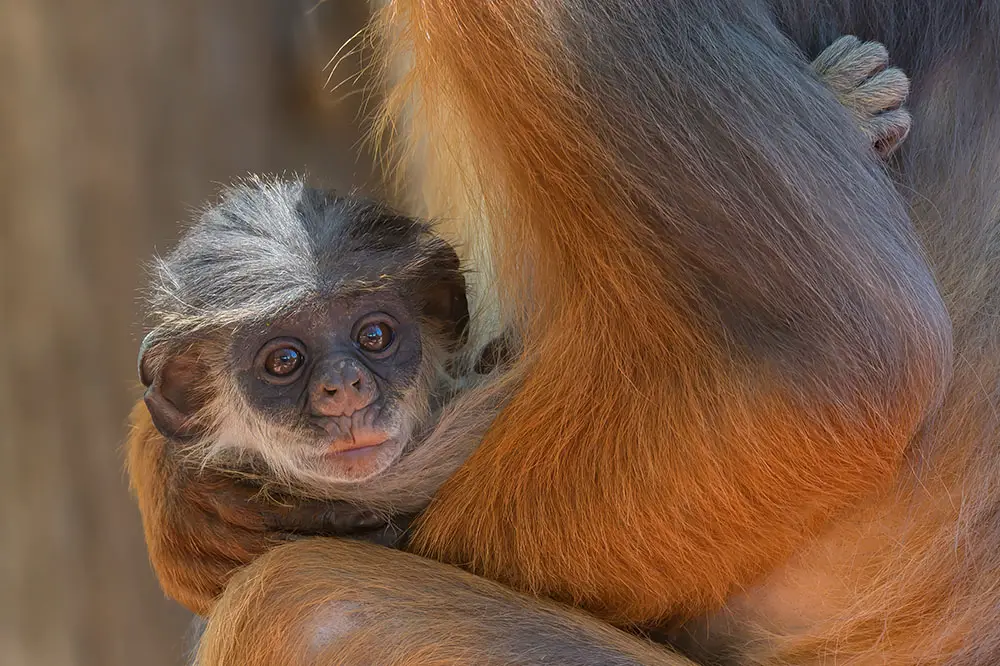
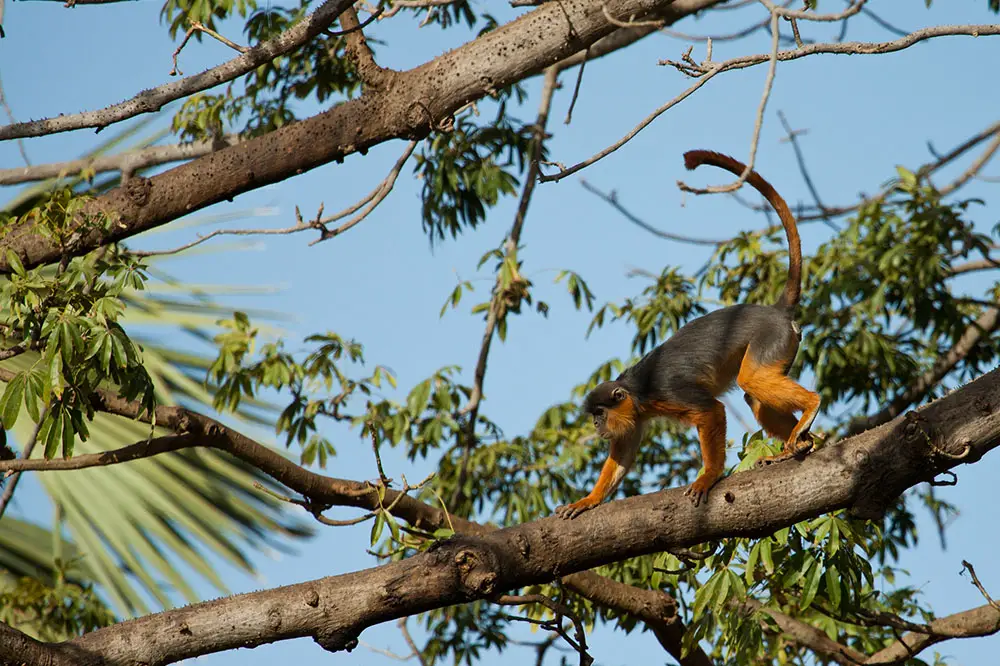
Left: Baby western red colobus / Shutterstock & Right: Western Red Colobus in the trees / Shutterstock
The Western Red Colobus is the last monkey we’ll discuss that is found in tropical forest as we move further north into the tropical grasslands that border the Sahara.
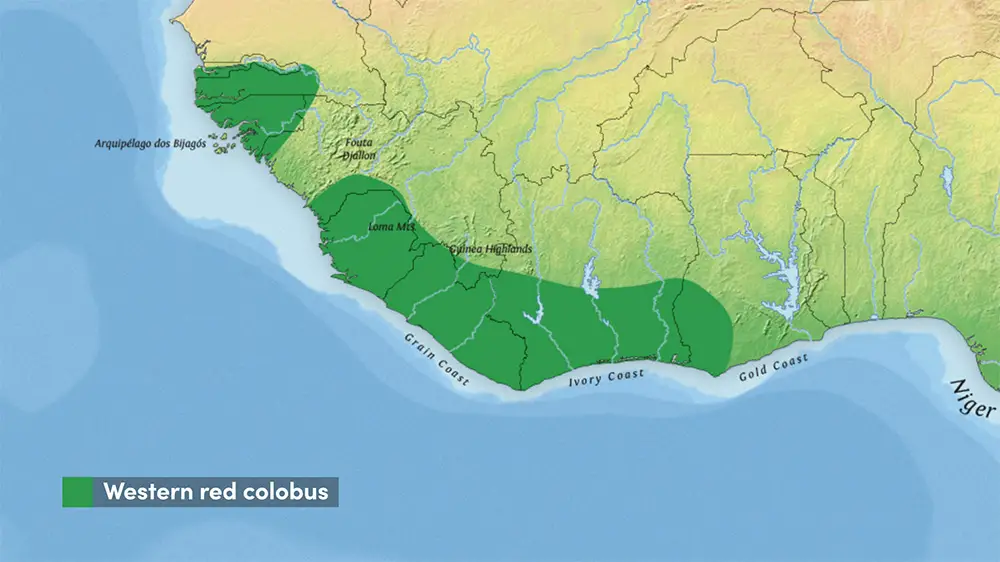
Patas Monkey | Erythrocebus patas
Given this ecological preference, the Patas Monkey is classed as terrestrial and well-adapted for life on the ground, although they can and do climb trees to sleep and to find food such as birds’ eggs. Their long limbs are more suited to terrestrial locomotion and facilitate surprisingly fast running speeds of up to 55 km per hour (34.2 mph). The colouration of their pelage is also quite unique with a mixture of red, which and black fur and, although I barely found a photo to support this, is yet another species of primate with a blue scrotum. Patas monkeys are one of the largest animals on this list and are highly sexualy dimorphic with females weighing up to 15 lbs (6.8 kg) and males almost double the weight at just under 30 (13.2 kg / 29 lbs).
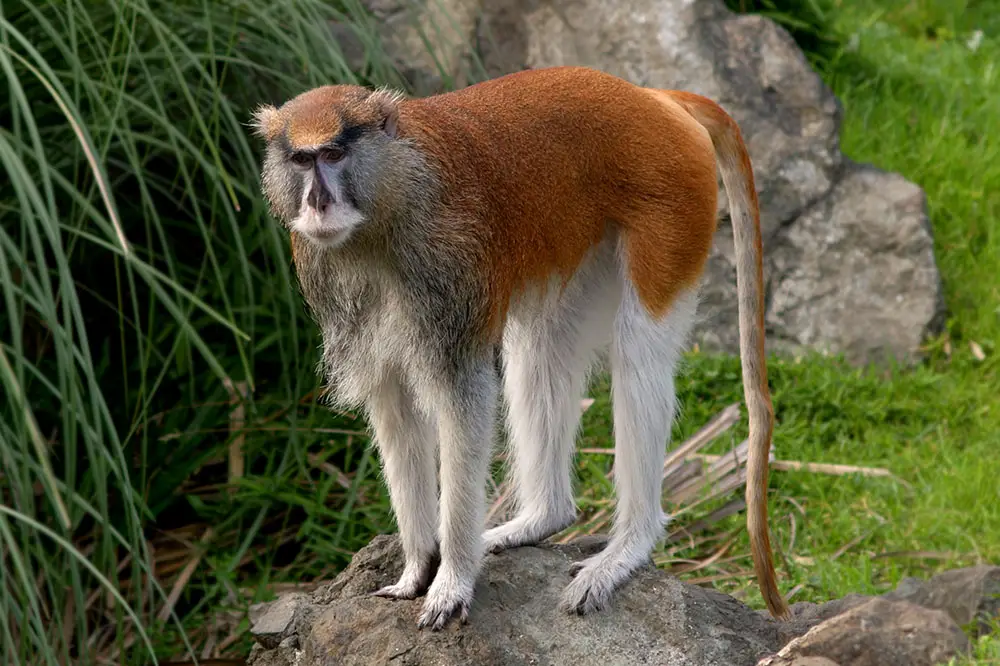
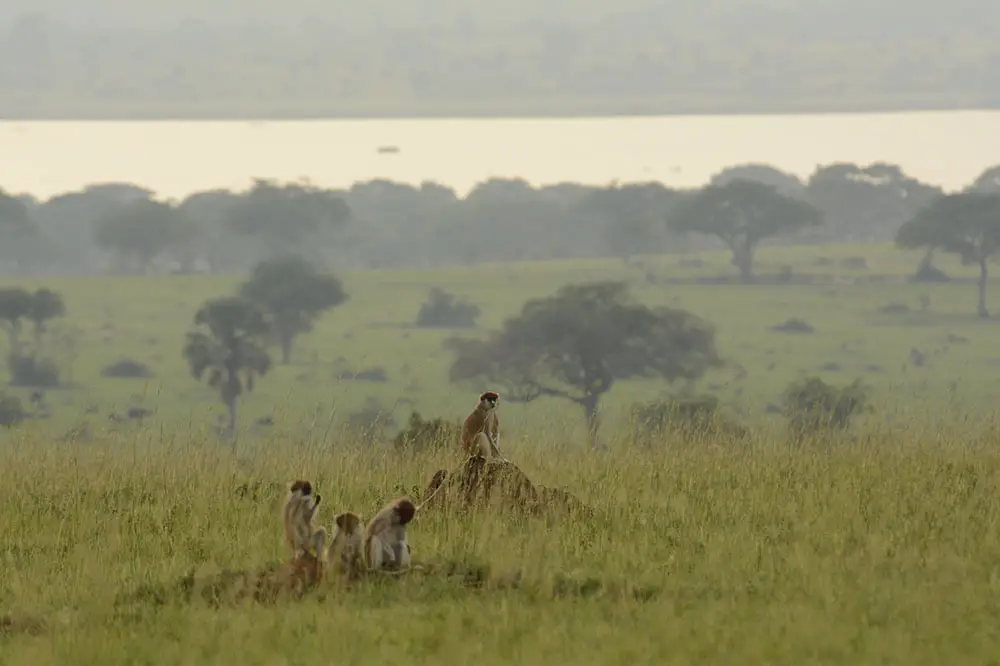
Left: Adult patas monkey / Shutterstock & Right: Patas monkeys in the grasslands of West Africa / Shutterstock
The range of the Patas monkey is one of the largest on this list, stretching almost the width of the continent and sits just below one of the most spectacular areas in Africa.
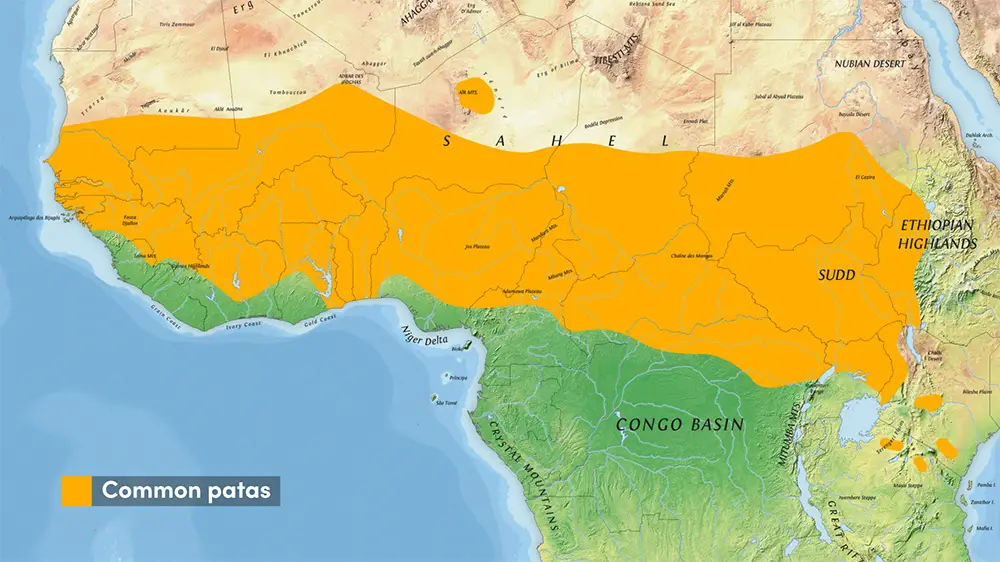
North Africa
North Africa is arguably the most unique region of the continent, characterised ecologically by the largest non-polar desert in the world, the Sahara, measuring 9,200,000 sq km (3,552,140 sq mi), which is larger than the entire contiguous United States. This area is not completely uninhabitable however, with many species of animal calling this barren land their home.
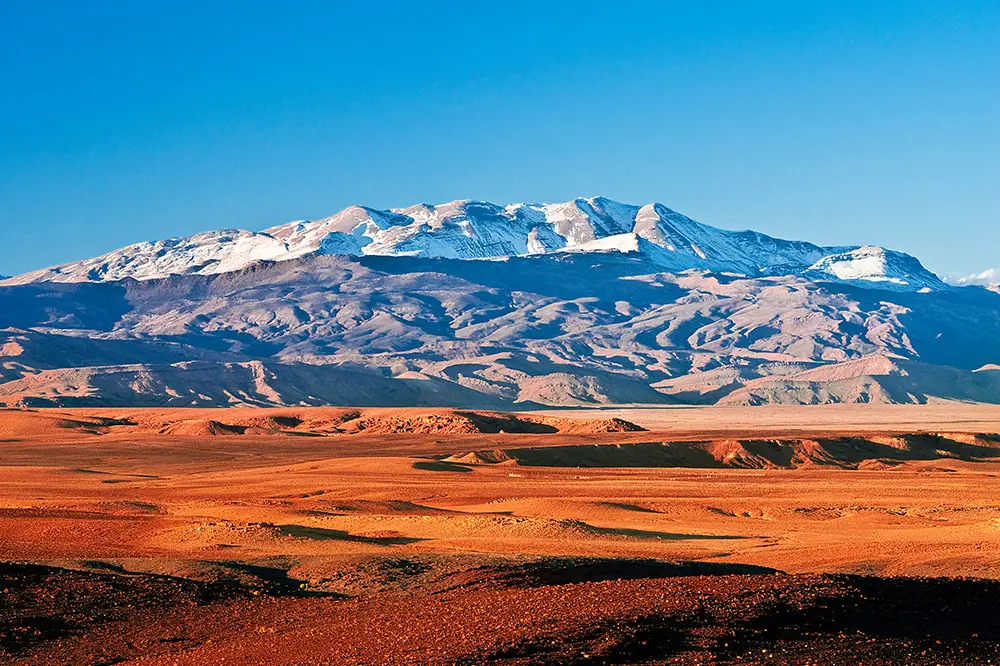
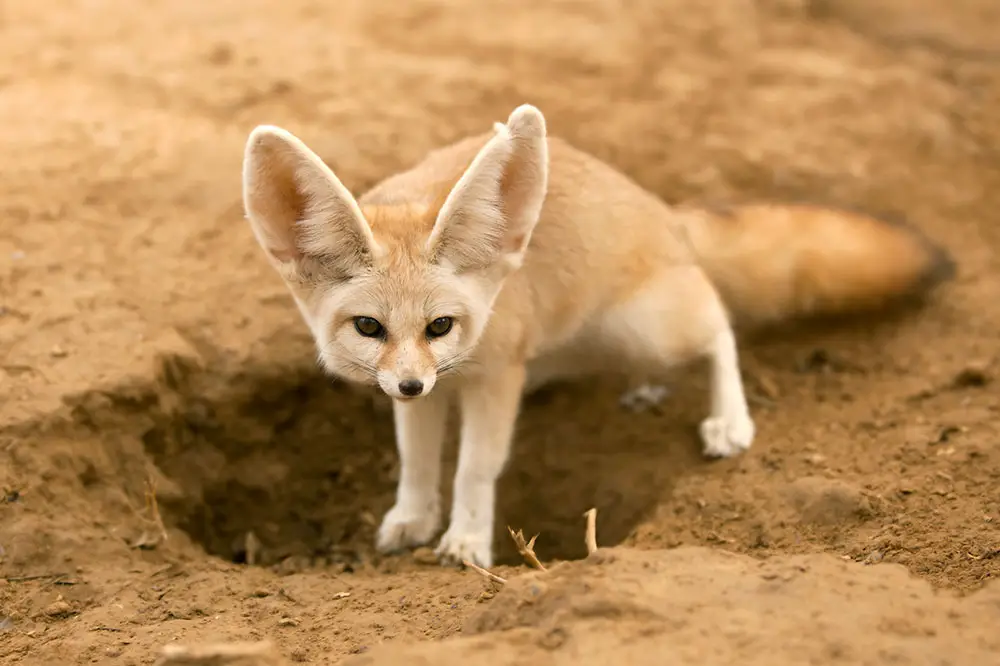
Left: Mountainous landscape in Morocco / Shutterstock & Right: Fennec Fox in the desert / Shutterstock
This region also features the Atlas mountains, which rise over 13,500 ft (4,167 metres / 13,671 ft) and play host to our final African monkey species.
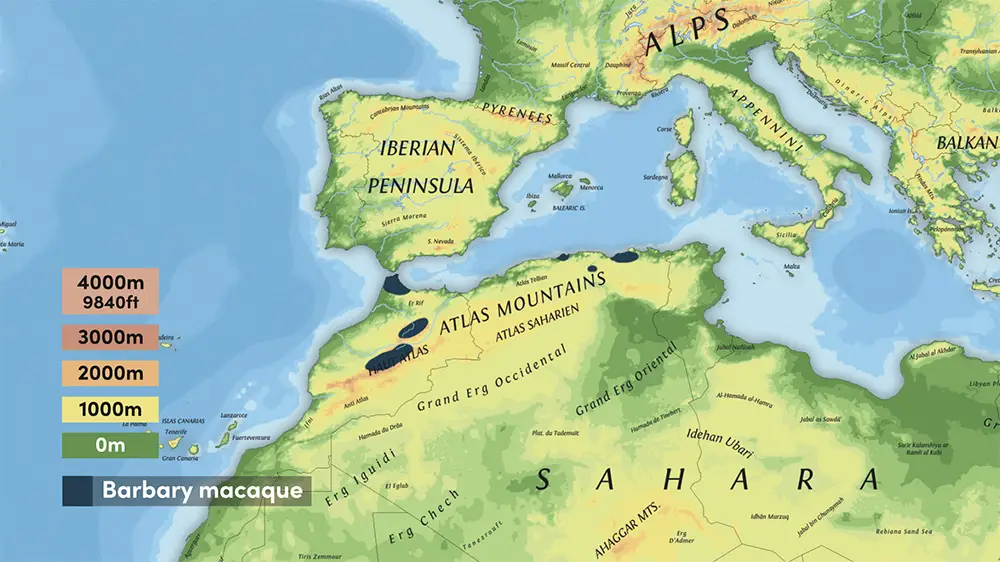
Barbary Macaque | Macaca sylvanus
The Barbary macaque is the only monkey species on the continent to abide north of the Sahara and the only non-human primate present in the wild in Europe, with a small introduced population residing in Gibraltar. At up to 35 lbs (16 kg) they are larger than any species previously discussed and have thick fur, allowing them to live at altitudes of up to 8,530 ft (2,600 m). Another distinguishing characteristic is the almost total lack of a tail, which is more of a stump in this species and referred to as a ‘vestigial’ tail. These monkeys mate in November and December and after a gestation period of 160 days, give birth, usually to a single offspring, between April and June. Once mature, females have an interbirth interval of between 13 to 36 months and live on average 22 years in the wild.
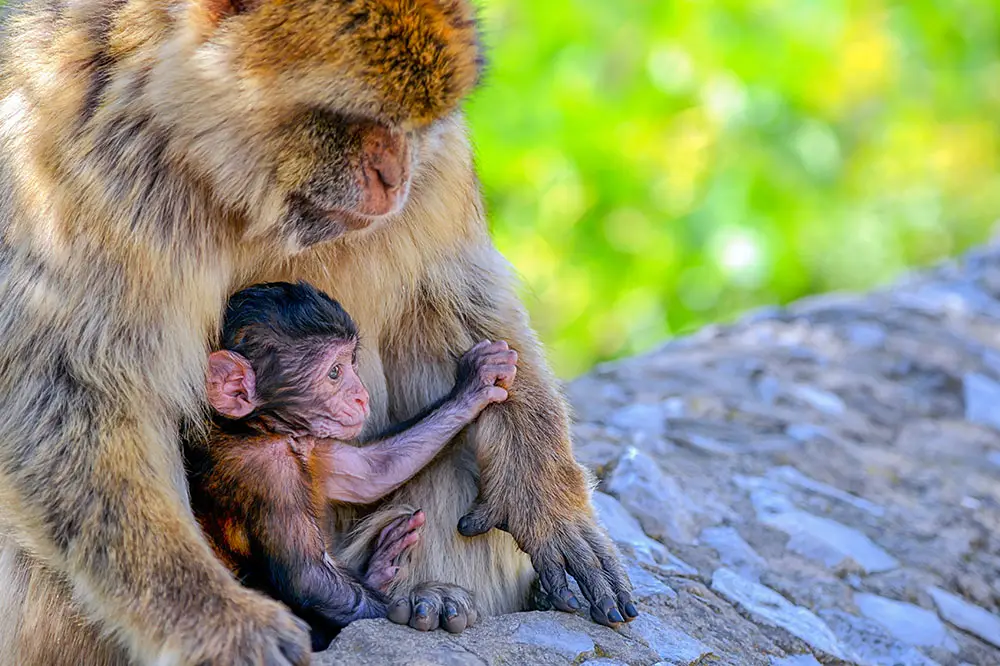
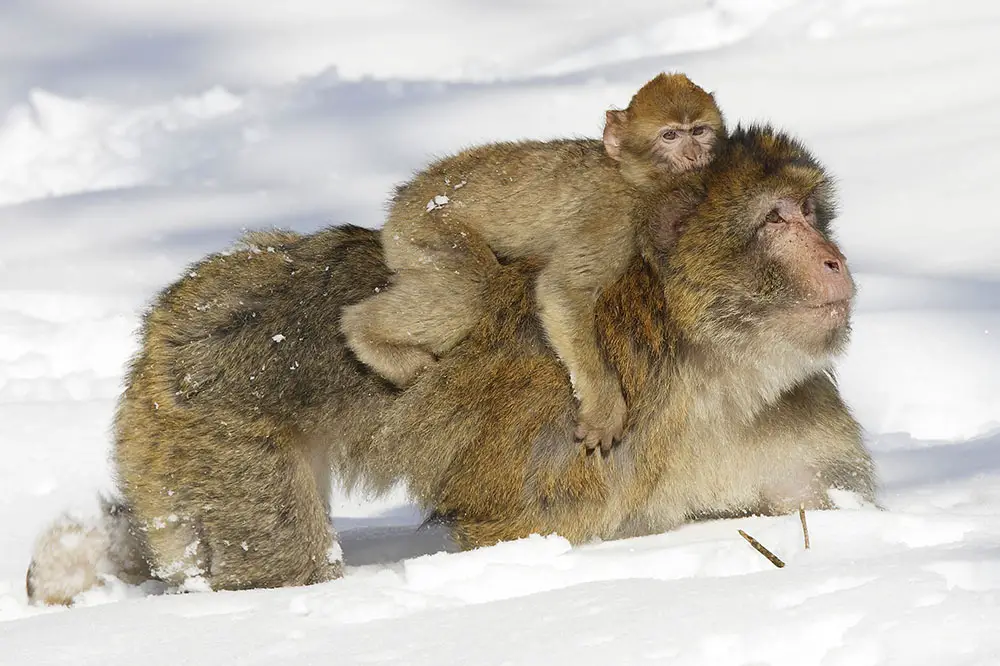
Left: Barbary macaque infant suckling / Shutterstock & Right: Barbary macaque with infant in winter / Shutterstock
Sources
New England Primate Conservancy, Animal Diversity, Wisconsin National Primate Research Center, Encyclopaedia Britannica, IUCN Red List, Wikipedia, Vervet monkey scrotum colour, Blue monkey pelage variation, Zanzibar red colobus study, De Brazza’s monkey social structure, Monkey monogamy, Talapoins, Western red colobus & Barbary macaque.
